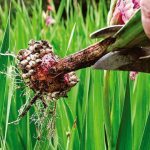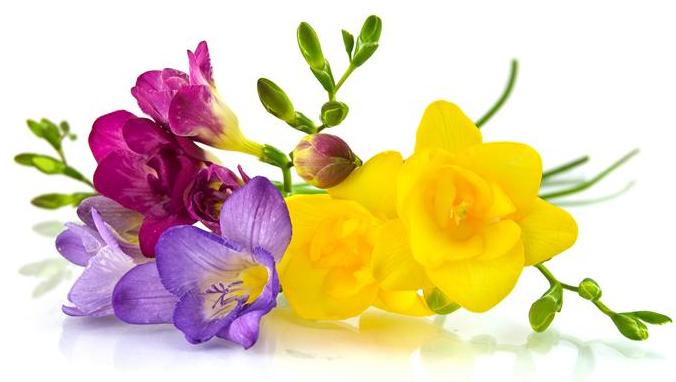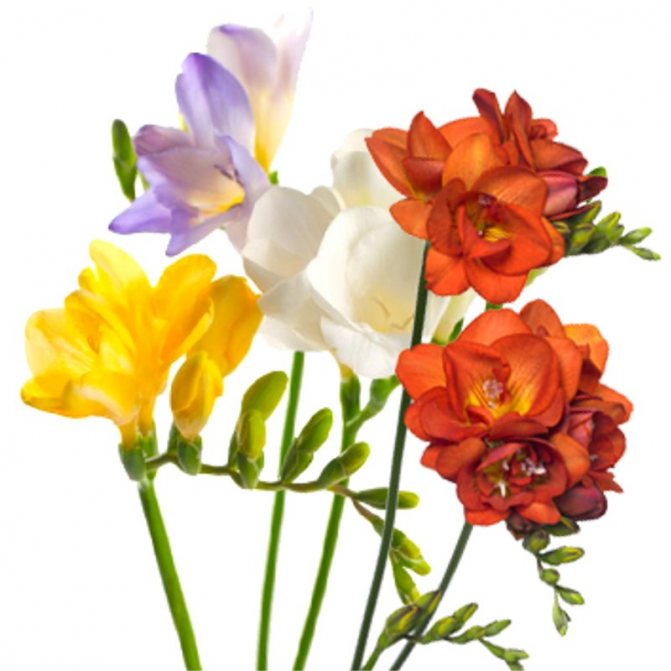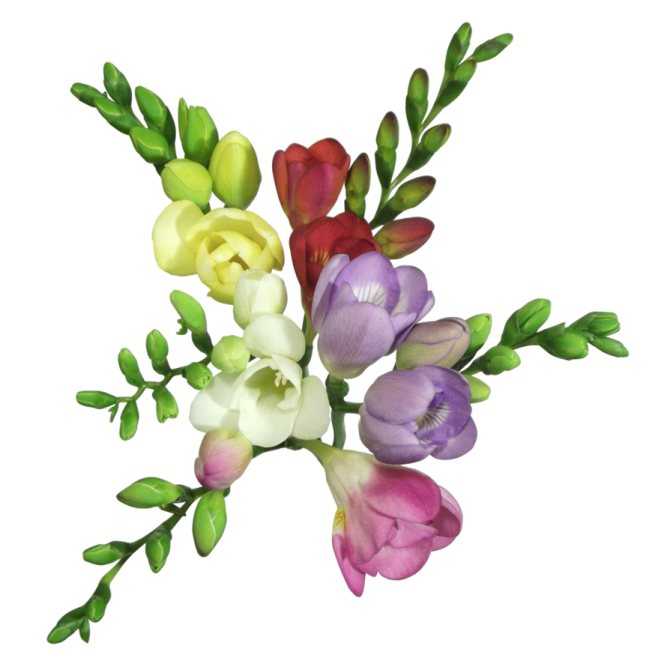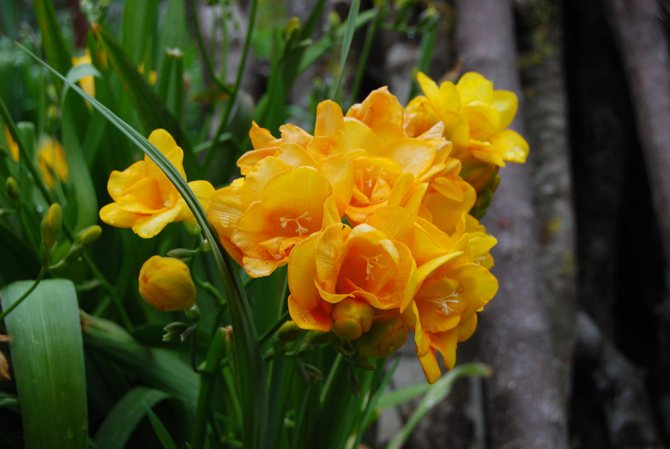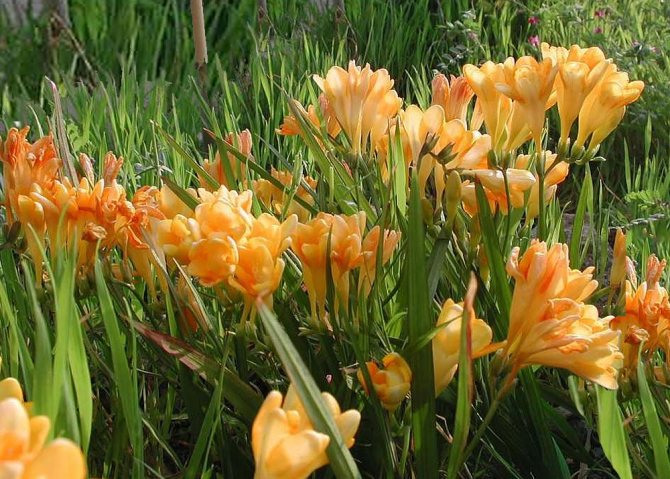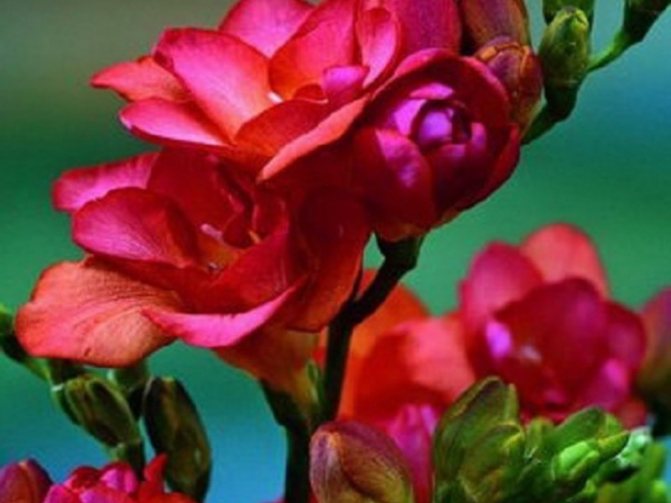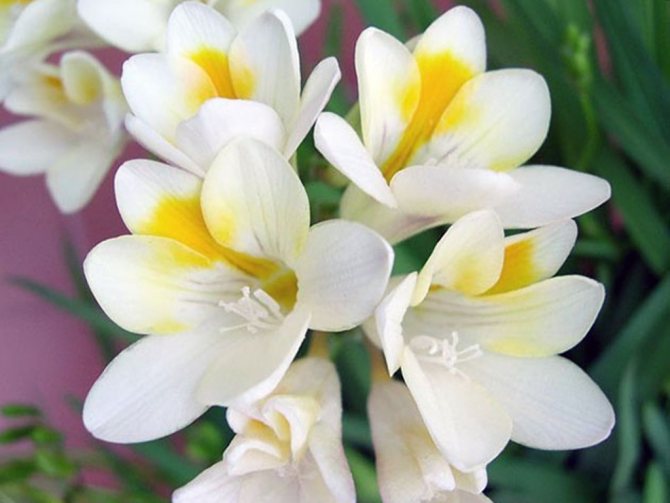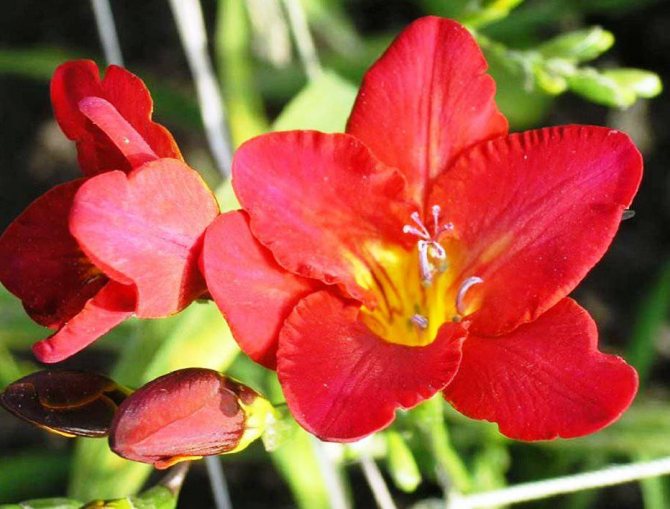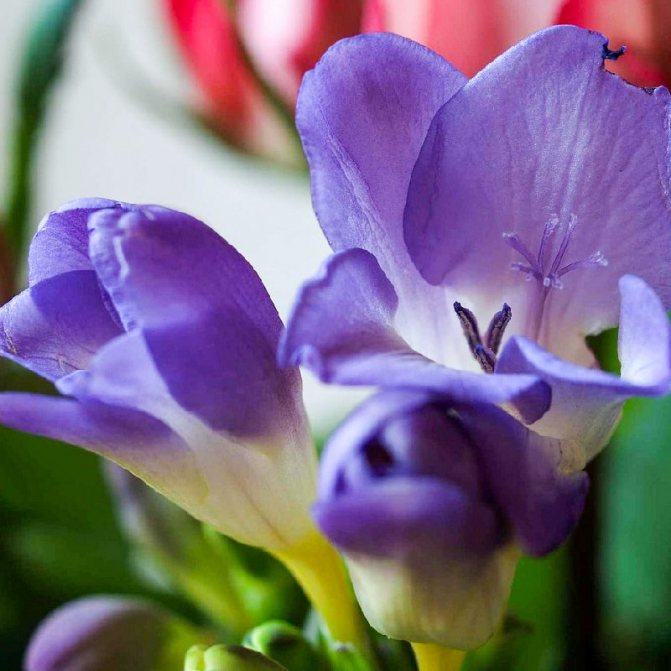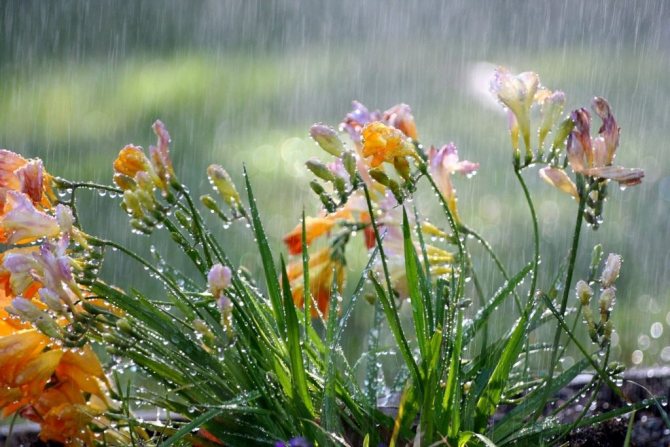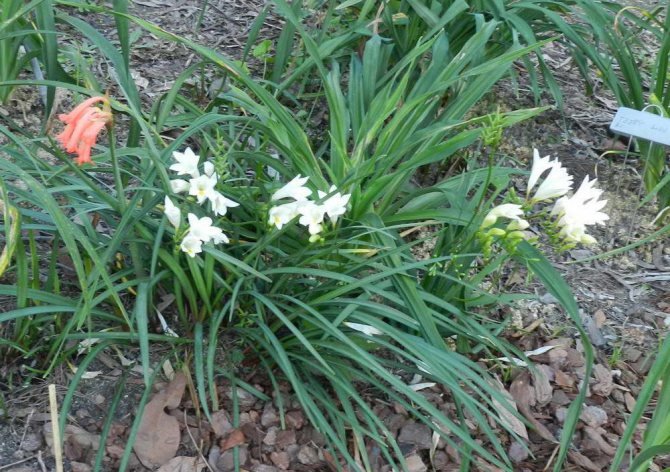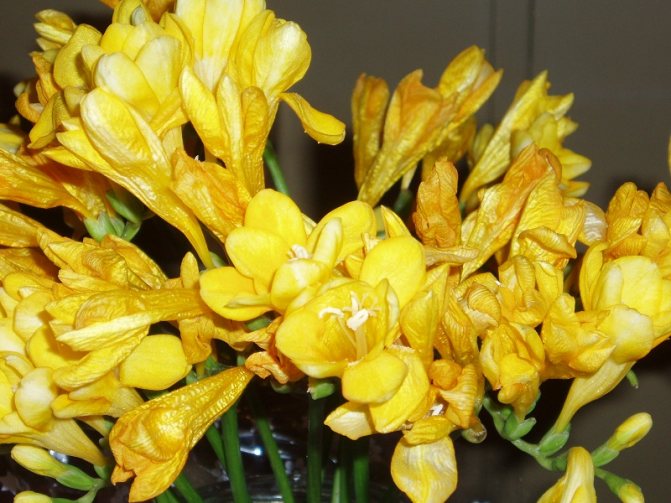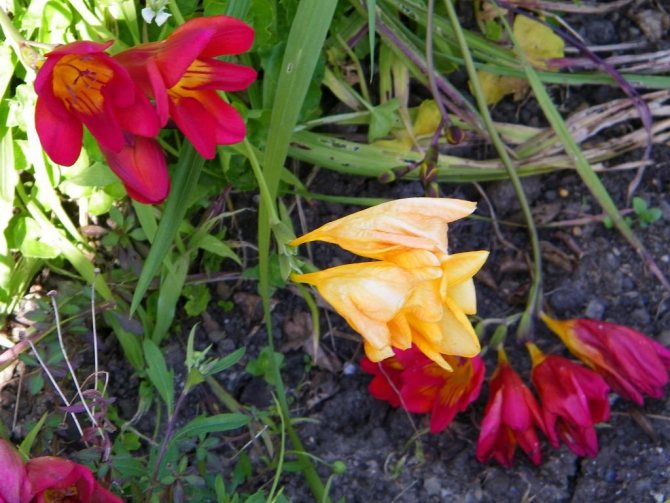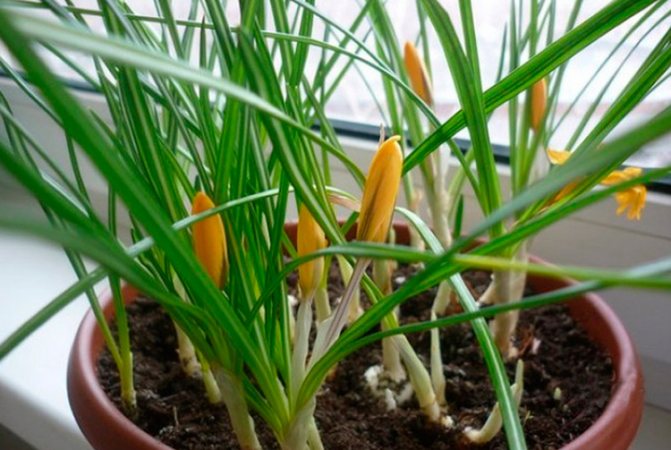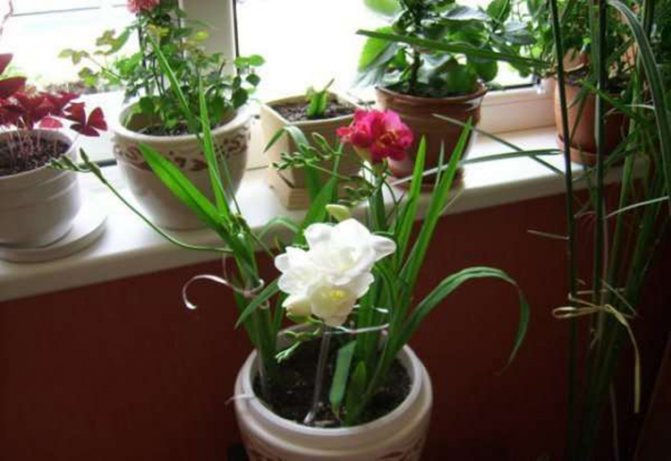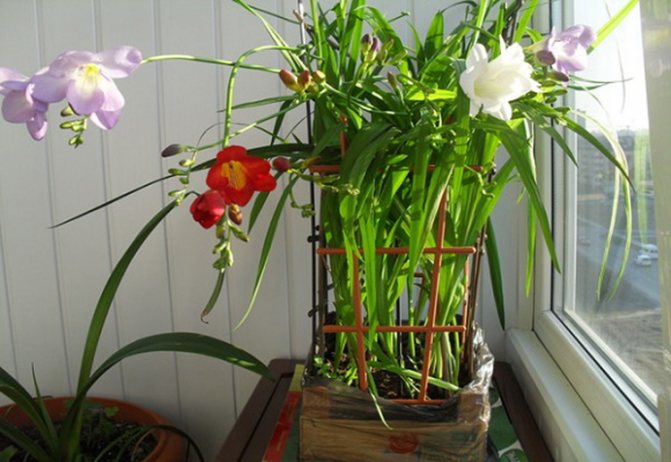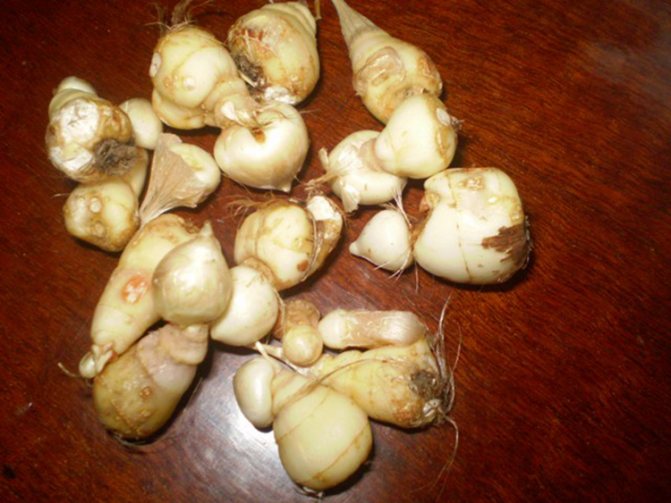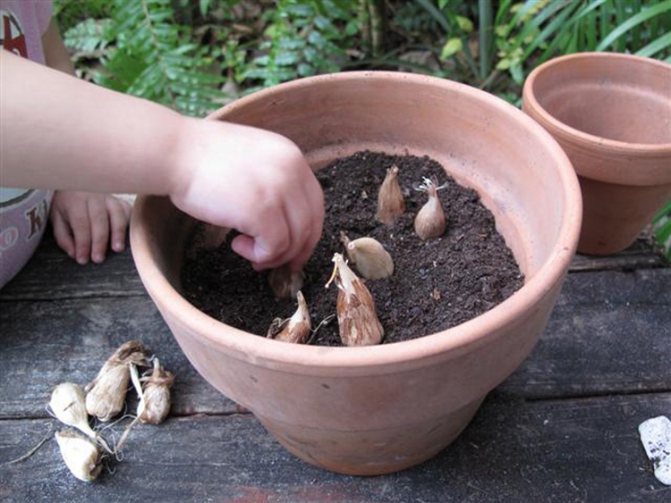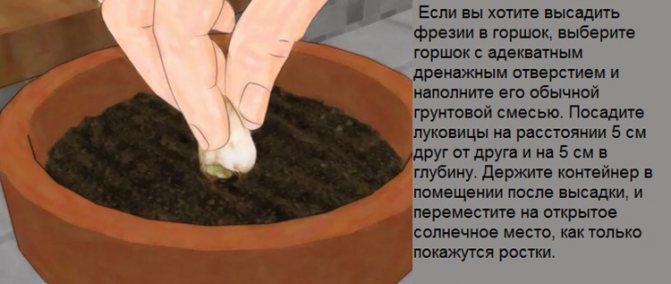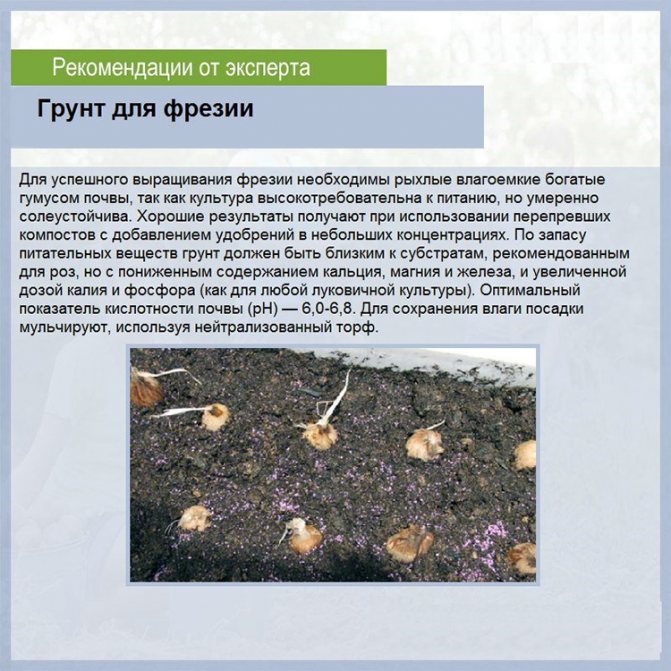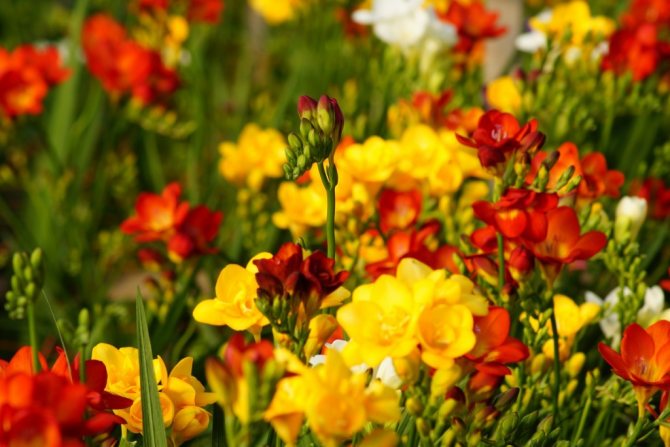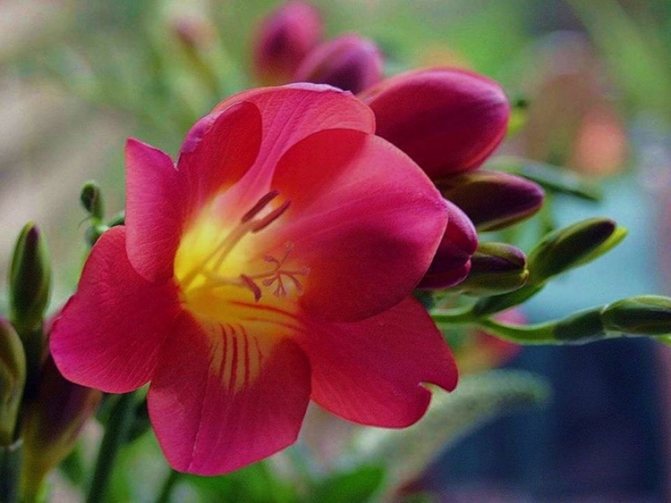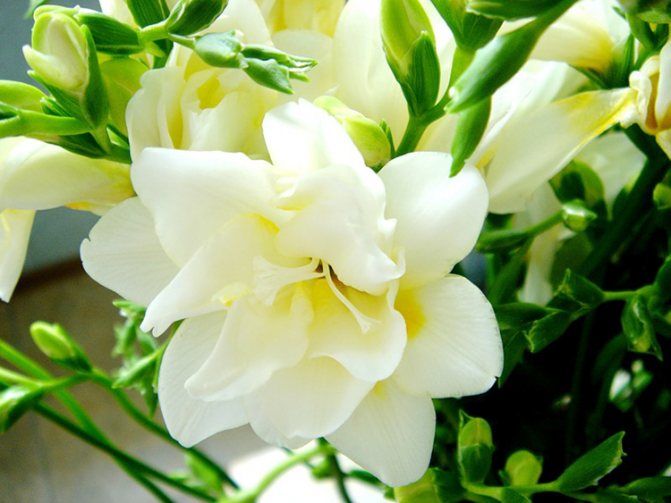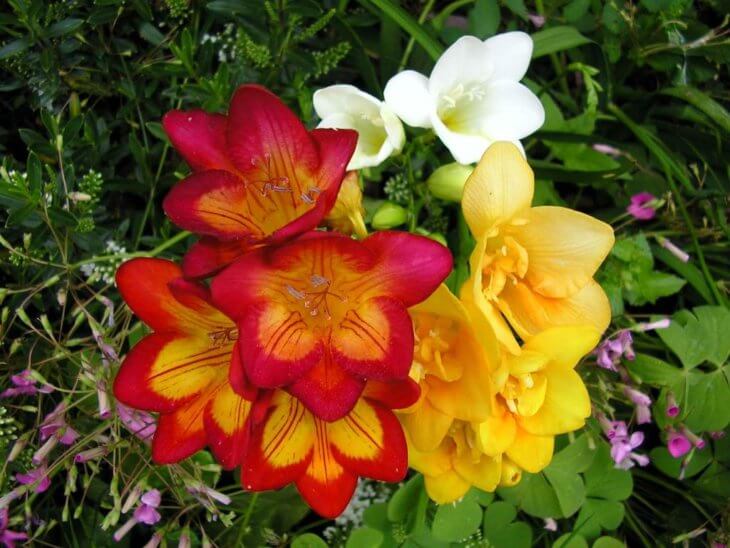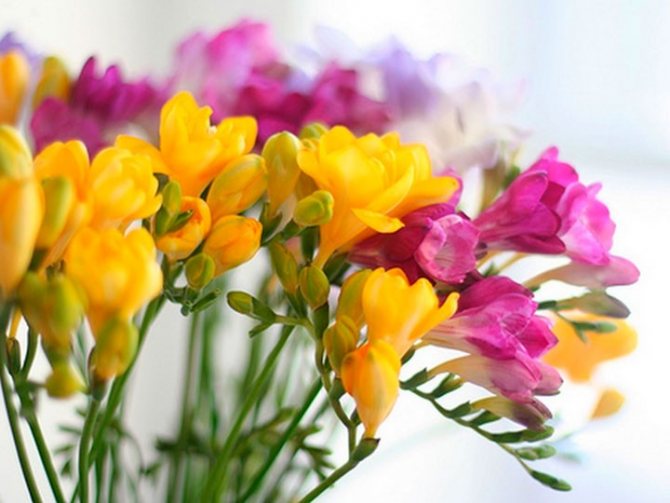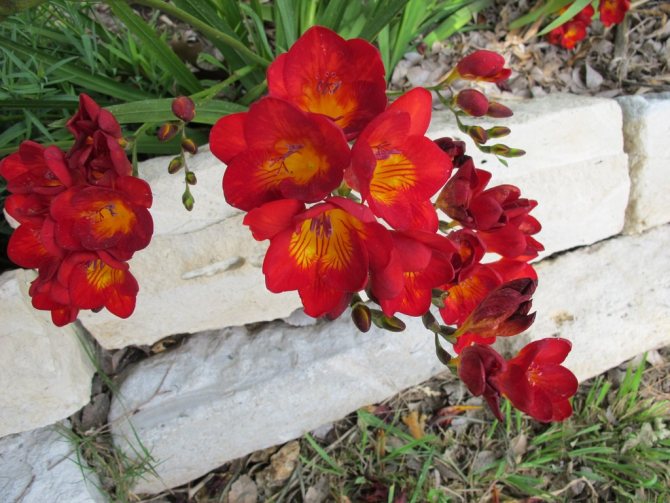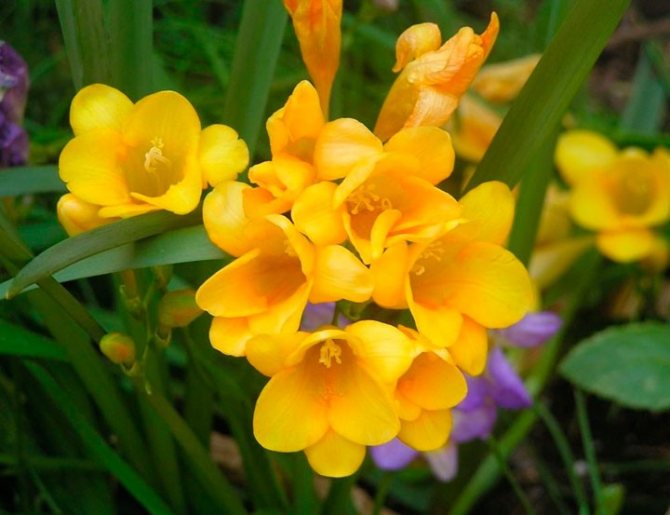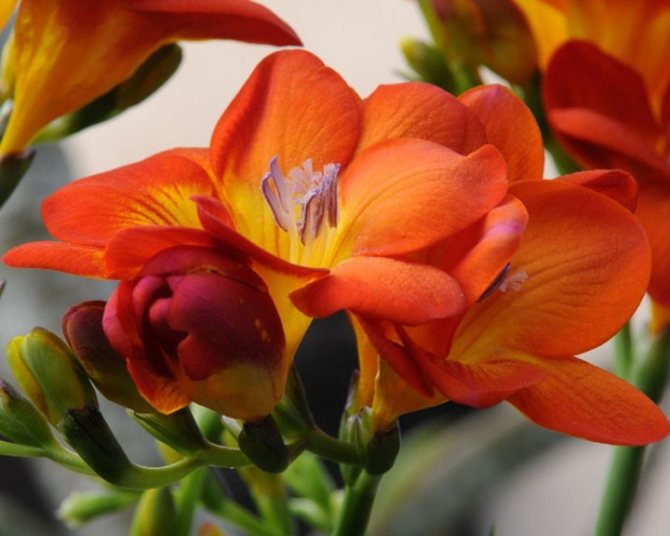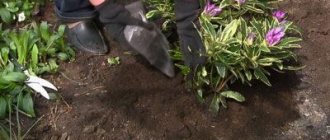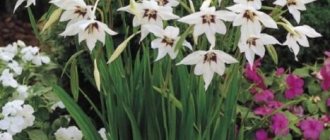- Freesia storage rules
- How to keep freesias in winter
- Freesia after flowering
- Freesia flowering periods
Freesia is a unique flower that has an interesting color and pleasant scent. This plant can be in the ground before the onset of the first frost, and then it must be dug up. Storing freesia in winter is not a very painstaking job, since ensuring optimal conditions during this period is the main guarantee of the re-flowering of this exquisite plant.
Freesia storage rules
Speaking about storing pink freesia at home, you should definitely say that the bulbs need to be dug out for wintering indoors. Since in winter these flowers need a special temperature regime. To understand whether it is possible to dig up a plant, you should pay attention to the following features of the flower:
- The leaves turn yellow;
- Dig up the bulbs as soon as all the leaves are completely dry.
The dug out bulbs must be carefully cleaned, then treated with a special disinfectant solution, and only then proceed to drying them. You need to store freesia in a room with an air temperature of at least 25 degrees.
It should be said that the freesia flower in winter is strictly forbidden to be planted in the ground, unlike tulips. Many novice gardeners are often faced with such a question as whether it is necessary to dig out freesia for the winter. To this, many experienced housewives answer that in most cases it is necessary to do this. Leaving the bulbs in the ground for the winter is possible only if you live in an area where there is no severe frost. In this case, their landing sites will need to be additionally covered with dry foliage.
Problems, diseases, pests
In gardens, freesia affects aphids, spider mites and thrips. It is not difficult to detect these pests during examination. Treat flowers with insecticides.
With improper care, freesias are affected by fusarium, rot and scab. You can avoid these diseases by setting up watering with settled cold water. Do not water the flowers in bright sun, but do not drag out the time for moistening the beds - the leaves should dry before night. Do not plant flowers too close to each other so that there is no stagnation of air during a humid and warm summer. Rot and fusarium can be treated with fungicides.
Viruses can cause flower and leaf necrosis. Infected plants will have to be disposed of to prevent the virus from spreading to other flowers.
How to keep freesias in winter
To ensure the successful storage of freesia before planting, the hostess should provide her with two main conditions:
- Increased humidity level;
- Stable warmth.
How to ensure good humidity. For most gardeners, to create optimal conditions, you can design a special structure that crumbles a water bath. You will need to take a small container, at the bottom of which you need to pour water, put a sieve on top and put the onions on it.
Watch a video on how to store freesias in winter.
But, keep in mind that the sieve should not touch the water and keep the container at room temperature. After a while, the water will be, will slowly evaporate, thereby increasing the humidity. You just need to periodically add water and make sure that the bulbs are not in the water.
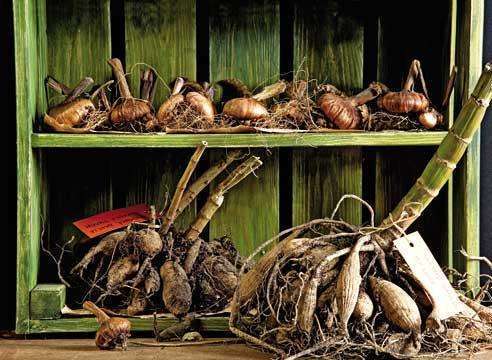
Freesia after flowering
Gardeners should not forget that a faded freesia needs the same kind of care as a plant that is still in bloom. So, caring for room and garden freesia is slightly different. The characteristic differences include the following points:
- Indoor freesia. After flowering is complete, the stem is cut off, and the bulb itself needs to be watered for another month. During this period, new young steams will appear on the bulb. You need to take them out of the pot and leave them in potassium permanganate for about thirty minutes, then dry them for a couple of days and put them in storage;
- Freesia that blooms in the garden. Garden freesia bulbs should be dug up in October. Cut off the stems, and thoroughly peel the bulb itself of earth and scales. As well as indoor flower, bulbs, need to be treated with potassium permanganate, then dried for several days. After that, the bulbs must be sorted, leaving large and damaged bulbs in separate containers.
Winter storage of freesia bulbs consists of three main stages:
- Drying the bulbs for a week in a room with a temperature of 25 degrees;
- Storage of bulbs throughout the winter period at a temperature of at least 25 degrees;
- A few weeks before planting, the bulbs are transferred to a room in which the air temperature should be 10 degrees. But, do not forget about the need to create high humidity in this room as well.
Freesia flowering periods
Answering the question - how to preserve freesia in winter, it should be said that the storage of corms is determined depending on what kind of flowering you want to get in the next season. When choosing a period when freesia blooms, you need to adhere to the following recommendations:
- Early flowering. To achieve early flowering of freesia, the bulbs must be placed in a room with a temperature above 25 degrees for two weeks, and the humidity level must be at least 60%;
- Flowering during the natural period. As soon as you dig up the bulbs, they need to be cleaned and dried, and then left for 15-16 weeks in a room with an air temperature of at least 27 degrees.
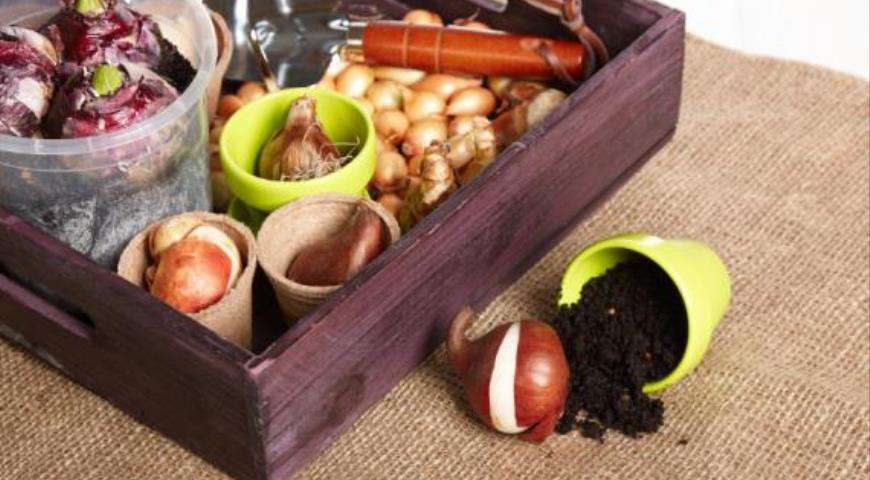

In order for the hybrid freesia to bloom as late as possible, the bulbs, after being dug up, are immediately sent to storage at a minimum temperature of + 5 degrees. Planting bulbs should be kept at this temperature for six to nine months. Then the tubers need to be processed and planted in the soil.
Many gardeners pay attention to the fact that if the plant is several years old, then it is imperative to divide the corms. When dividing the bulbs, the following guidelines should be followed:
- Get the plant out of the ground very carefully so as not to damage the corm system;
- A lump of earth should be put on paper;
- Begin slowly and carefully to separate the bulbs from each other.
Remove the parent corm. This is most often the largest bulb on which the smaller bulbs are located. The parent corm, in simple terms, is last year's material, which nevertheless connects with its offspring. The separated parts must be placed in a dry room, that they have dried up, and only then sent to storage.
Thus, based on the foregoing, it is possible to accurately answer the question - is it necessary to dig freesia for the winter, then yes it is done without fail. Only in this case, you can save the plant bulbs, because they will not tolerate frost and you just have to throw them out. Therefore, it is better not to be lazy, but dig up the bulbs in a timely manner and provide them with normal storage conditions.
Share your winter freesia storage experience in the comments. And also watch a video on what to do if freesia started growing at the wrong time.
The birthplace of this amazing flower is South Africa.In the 18th century, freesia began its triumphal march across Europe and then around the world. This flower belongs to the class of perennial bulbous plants. The flower was first described by the German scientist Friedrich Frezza, and it got its name in honor of him. Since freesia is quite unpretentious, many amateur gardeners started growing it. In this article, we will provide some tips for growing and caring for this plant.
Site preparation, soil and planting material
The key to the active development and lush flowering of the freesia plant is growing and care in the open field in compliance with all the necessary instructions and recommendations.
Eustoma flowers: planting and care in the open field
Freesia needs natural light every day for half a day. In this case, direct sunlight has a harmful effect on plants. The best condition for a flower is partial shade. It is also necessary to provide protection against drafts. The soil should be loose with a good drainage system. The composition of the soil should be present in the same amount:
- humus;
- sod;
- peat;
- leafy land.
The acidity of the soil should be low. The distance between the bushes depends on how the crop is growing. If the flower is spreading and broad-leaved, then the varieties are planted away from each other so that they can develop freely. Varieties with narrow leaves and small flowers are more compact.
Important! To achieve a dense flowering, you need to observe a strict temperature regime: before the beginning of the flowering period, the air must warm up to 22 ° C and no more.
Freesia reproduces in several ways:
- seeds;
- corms;
- tuberous.
For planting plants in open ground, the second option is optimal. If the bulbs of an adult plant are used for this, then they must be stored in a dry room with good ventilation and an air temperature of 25 ° C to 27 ° C. At the end of winter, this figure should be reduced by about 3 times. Failure to comply with these requirements will lead to the fact that the peduncles cannot develop.
Before planting freesia, you need to carefully prepare the planting material. Tubers are prepared for placement in the ground in early March. The process is as follows. Freesia bulbs are placed in pots with soil. There are 6 tubers per vessel with a volume of 3 liters and a diameter of 12-15 cm. The pots are placed in a well-heated (25-27 ° C), humid room. For 15-18 days, it is important to ensure that the soil does not dry out. After this, the line "aristocrat" is ready for disembarkation.
Freesia planting conditions
Planting bulbs
You can plant a flower both with a bulb and with seeds. If you have bulbs, you can start planting outdoors in late April or early May. This plant is native to Africa, so early planting can kill it. The place of planting is of great importance - the flower is afraid of direct sunlight, guided by this, and you need to choose a place.
The planting depth of tubers largely depends on the "severity of the soil". The heavier the soil, the shallower the planting depth should be - with heavy soil, the depth ranges from 6 to 10 cm, with light from 12 to 15 cm. The distance between large tubers should be 5-6 centimeters, small 3-4 cm.
Planting seeds
Seed preparation should be started a month before planting in the ground. Prepare a container with a substrate, sow seeds there, sprinkle it with a layer of substrate a few millimeters on top, sprinkle it with water from a spray bottle and cover with a film. It is important to know how to store freesia so that it blooms after planting the seeds. Until spring, store in a dark, dark place at a temperature of 10-15 ° C. Sprouted seeds are planted in the same way and at the same time as the tubers.
Brief description of the culture
The petals of this graceful, fragile and delicate plant have a variety of colors: from pale pink to blue.The stems of freesia are thin and long, covered with narrow, dark green xiphoid leaves. At the tops of the shoots are elegant racemose inflorescences.
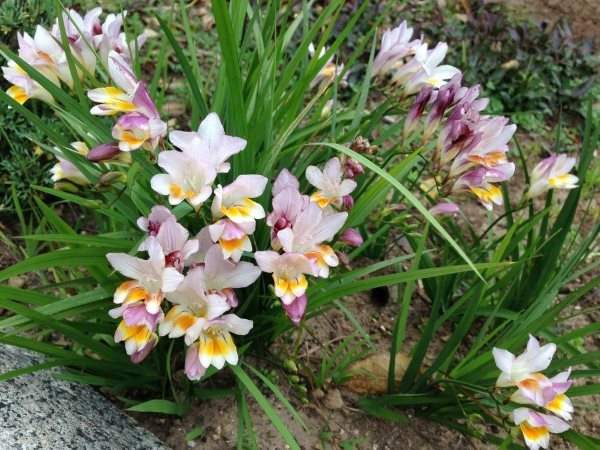

Freesia planting and care in the open field
Freesia is a perennial plant from the Iris family. Since the culture first appeared in a hot climate, it cannot tolerate severe cold weather. About 10 years ago, the flower was grown only in greenhouses for cut. However, thanks to breeding work, it was possible to develop new varieties suitable for growing in open ground not only in the southern regions of Russia, but in the western part of the country. In total, more than 20 types of freesia are known, of which only 3 are cultivated for home and garden cultivation.
For your information! The second name of freesia is Cape lily of the valley, which was given to her for the similarity of the aroma with the smell of lily of the valley.
The plant reaches a height of 1 m. The stem of freesia is highly branched. The flower has a corm covered with scales. The leaves are thin (only 1-1.5 cm wide), long (15-20 cm), a vein runs in the center of the plate. The flowers are 3-5 cm long. They grow in inflorescences, which are located in small numbers on one side of the stem. The color of the flowers can be very varied (white, blue, orange, cream, purple, pink, etc.). The fruit of freesia is a capsule.
Outdoor freesia flower care
You need to fertilize the plant twice a month with superphosphate, the solution is made at the rate of 30 grams per bucket of water. You also need to remember that freesia is afraid of excessive soil moisture, so you should not abuse abundant watering. Frequent watering with a garden watering can is best, and only the surface of the ground is moistened.
To avoid plant diseases, they need to be periodically treated with fungicides. Parasites such as aphids and mites can be treated with acaricides as needed.
Care features
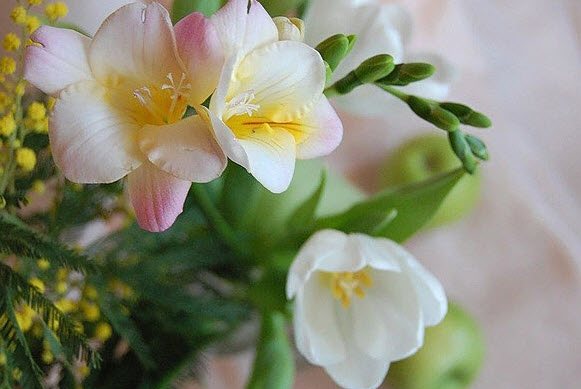

Freesias do well in warm shaded areas without drafts. The plant is capricious and requires constant attention, but with good care, the sissy will thank you in the second half of summer with wonderful fragrant flowers. The area with freesias must be loosened and weeded regularly.
Temperature
If, after planting the bulbs, the soil temperature drops to + 10 ° C, the flower stems will be short or will not develop at all. At temperatures above + 20 ° C, leaves will grow, and flowering will be modest.
Attention! Favorable temperature for freesias is + 18 ° C for air and + 15 ° C for soil. Small fluctuations of a few degrees are permissible. At optimum temperatures, plants will sprout within two to three weeks after planting.
Humidity
The soil for freesias must be mulched with three centimeters of soft peat or steamed straw. Mulching allows you to maintain optimal soil moisture and temperature.
During the active period, freesia needs regular watering at the root. Try to water the flowers so that the buds stay dry. In dry weather, it is advisable to spray the stems and leaves in the evening. At the end of flowering, watering is gradually reduced and completely canceled before digging out the tubers before freezing.
Watering
In the first two weeks after planting, the plants are watered regularly, while preventing waterlogging. When the active development of the leaves begins, the laying of buds and flowering, watering must be intensified. To prevent waterlogging and spread of infection, water the flowers in the morning, before sunset, the leaves must be dry.
Top dressing and fertilization
Freesia does not tolerate saline soils, so it is better to give preference to liquid fertilizers. Dry mixtures are contraindicated for this flower. In the summer, feed the flowers three times with a complex mineral fertilizer with nitrogen. Perform the first feeding of freesia with ammonium nitrate.After the sprouts appear, dilute 20 g in 10 liters of water, after every 14 days, feed the lily of the valley plantation with superphosphate solutions (40 g per bucket of water) and potassium salt (20 g).
How to grow freesia in a pot
In order for freesia flowers to please the eye and in winter they can be grown in pots in an apartment.
- It is better to plant tubers for winter flowering in October. For planting, you need to take a pot with a volume of no more than a liter, the diameter of the pot is 15-17 cm. Be sure to drain, soft and light soil on top.
- It is necessary to plant the tubers to a depth of 5-7 cm. And in 2-3 weeks the first sprouts will appear. It is better to keep the plant in good lighting, you can also on the glazed loggia, taking it into the house in severe frosts. If the room where the flower grows is not sufficiently lit, then you will need fluorescent lighting.
- Freesia requires 12-14 hours of lighting. It is better to water the flower from a sprayer, trying not to get on the flowers. It is recommended to put supports for the stems, since they are very fragile in freesias. It is also good to feed the plant a couple of times.
With good care, your beauty will bloom in 2.5-3 months. After the plant has faded and the vegetative period has passed (drying of the stem), the bulbs can be harvested and dried, stored until next fall.
The soil
You can plant flowers when the soil warms up to 10 ° C. Freesias require nutritious and loose soil. For development and flowering to take place without problems, add rotted humus (compost) and complete mineral fertilizer to the soil. The optimal neutral acidity is 6.0-6.8 pH. If the soil is acidic, lime the top layer in the fall or add dolomite flour.
Large tubers are planted with an interval of 5 centimeters, smaller ones - after 3 centimeters. The distance between the rows is 10 centimeters. Freesia has thin and brittle stems that often break off. To prevent this from happening, when the plants reach 15 centimeters in height, pull the twine between the rows.
Flowers like moist soil; to limit evaporation of water, mulch the soil with peat with neutral acidity.
On light soils, the planting depth is 12 cm, on medium soils - 10 cm, if the soil is heavy or the tubers are shallow, the planting depth should be reduced to 6 cm.
After planting, the site is generously watered and mulched to prevent the bulbs from drying out and rotting until a full-fledged root system is formed.
Advice. Do not press the sprouted tubers into the soil, even if it is well loosened. Prepare a separate well for each bulb and carefully place the planting material.
Boarding time
The usual time for landing in open ground is mid-April. Later, the earth warms up above + 15оС and the buds of inflorescences may die. The freesia will sprout, but most likely not bloom.
With a stable heat in the range from +13 to + 20 ° C, the plants will germinate in two to three weeks. With a cold snap, the peduncles can slow down growth, and with heat, the leaves grow to the detriment of the development of inflorescences. Freesias do not like heat and cold, at temperatures below + 2-3 ° C and above + 20-22 ° C, the flowers are deformed and empty buds are formed.
Advice. It is not recommended to plant freesia in open ground in the fall. A heat-loving plant is likely to die in frost.
How to preserve freesia after digging
After cutting the flowers, the vegetative period of the plant lasts for 3-6 weeks, it is at this time that young tubers are formed. During this period, you need to gradually reduce the watering of the plant. Tubers are harvested when the foliage on the trees begins to turn yellow.
The collected material is sorted and placed in a well-ventilated dark room for 5-7 days, the temperature should be around 28-30 degrees. Air humidity during this period should be 65-75%.
After heat treatment, it is desirable to pupate the tubers.To do this, they need to be placed for 6-8 weeks in a cool room with a temperature of 7-18 degrees. In the future, they can be sent for winter storage. Read on in our article on how to store freesia tubers and before planting.
Plant application in the garden
This magnificent perennial is used to decorate flower beds and mixborders. Tall varieties are used when decorating the background, and low ones look great along the borders.
Good combinations of freesia with herbs - thyme, thyme, lavender. From tall shrubs, coniferous shrubs are suitable for neighbors - thuja, juniper. Bright bells look very impressive against their green background. Perennials are planted in groups using bulbs of different varieties. This cultivation method will allow you to get a multi-colored fragrant round dance in a flower bed.
How to store freesia bulbs in winter
Most experienced gardeners recommend storing freesia bulbs in a humid environment at 20-25 degrees Celsius. If you do not have such a room in your house, then you can place a net with bulbs over a vessel of water. If you live in a place where there are no harsh winters, then you can leave the bulbs in the ground, covering them with dry leaves.
Many gardeners are wondering how to store freesia terry mixture, this flower variety is stored, just like other varieties of freesia.
Popular types of freesia
When buying freesia bulbs in flower shops, you can choose a separate variety or purchase a freesia mix - a set consisting of flowers of various shapes and colors. This flowerbed bouquet will decorate any garden area or front lawn.
The most valuable are flowers from Holland - super freesia with high stems and large inflorescences.
In temperate climates, varieties take root:
- Carmen is red.
- Rose Maria, San Malo - pink.
- Mozart, Valenti, Zephyr - lilac.
- Golden Milady, Topaz - orange.
- Apollo, Diana is white.
The newly emerging Dutch freesia Sunbeams has a robust stem and gorgeous, fragrant orange flowers with red stripes.
Freesia Armstrong


Red flowers bloom in late spring and are fragrant in the garden until July. Panicle inflorescences on well-branched stems up to 70 cm high are framed by long thin leaves. The most famous variety of this freesia is Cardinal.
Broken freesia


A small plant does not stretch above 40 centimeters. The flowers are white or yellow. It blooms earlier than other types of freesia - in April, with the onset of the first warm days. In the Russian climate, two types are popular: Odorata (yellow) and Alba (white).
Freesia hybrid
The result of crossing a broken freesia and an Armstrong. A tall plant grows up to a meter in height. Large flowers are collected in abundant inflorescences. The hybrid has incorporated the best qualities of the parents. A tall, branched bush, richly blooming with fragrant inflorescences of purple, raspberry, yellow and other colors. Varieties of this variety:
- Ballerina - with corrugated white and yellow flowers.
- Rose Marie is a miniature flower up to 25 cm in height with crimson-white flowers.
- Pimperina is an even shorter species (up to 20 cm), generously strewn with red corrugated flowers with a yellow base of the petals.
- Vinita Gold is a bright orange flower.
- Royal Blue is a blue variety of freesia.
How to save cut freesia (cut)
The question is often asked how to keep a freesia bouquet for as long as possible. To keep flowers fresh and pleasing to the eye, it is better to put them in a container of water in a package. You should not put the bouquet in the sun, it is better to place it in a well-ventilated area away from direct sunlight. The water needs to be changed every day.
As much as you love begonias and dahlias, freesias and gladioli, do not buy their tubers and bulbs in incredible quantities. Do not forget that until next season they will still need to be kept at home and planted again in the garden in the spring.
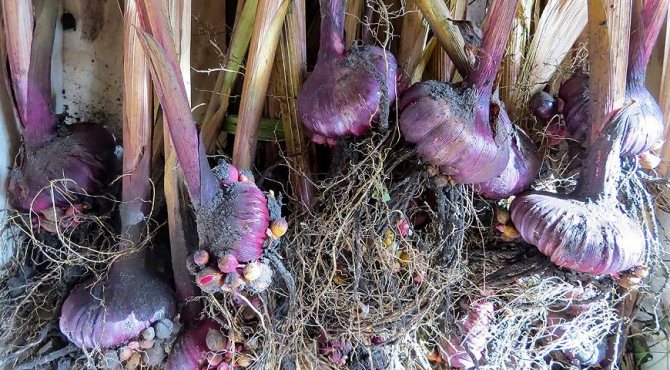

- Dahlia (Dahlia)
- Gladiolus (Gladiolus), tigridia (Tigr> Many novice growers in the fall try to stock up on more tubers and bulbs, without thinking about how to properly prepare corms and root-tuber crops for storage, and in the spring they find that the planting material is spoiled.
To prevent this from happening, you need to assess your capabilities and desires: if you do not have a cellar, garage or glazed veranda, that is, any room where you can maintain a temperature of +5 throughout the winter. + 8 ° С, you should not chase the quantity. Make sure the tubers and bulbs to be stored are perfectly healthy and ripe. When storing planting material, consider the characteristics of each crop.
During the winter, all stocks are reviewed at least once a month. If there are signs of fungal diseases - rot, spotting, mold - the affected areas are cleaned and treated with brilliant green or colloidal sulfur. Severely affected tubers and bulbs are removed immediately so that they do not become a source of infection.
Answers to questions from gardeners
How long does freesia live?
It is difficult to predict how long a demanding freesia will survive outdoors. Every fall, be sure to dig up the tubers along with the dried overhead part. Corms are the main plant organ, the most vulnerable and sensitive. Unlike other perennials, freesias cannot survive a frosty winter in the ground. Keep dug up bulbs warm and you will retain the varietal properties of the freesia next spring.
How does freesia winters?
After flowering, when the freesia leaves begin to turn yellow, but have not yet dried, the tubers should be carefully dug up. The stem with leaves is cut off after the bulb is removed from the ground. The corms are cleaned of scales, roots and put for half an hour in a weak solution of potassium permanganate or fungicide (foundazol, phytosporin). After the tubers are dried for several days in a well-ventilated place, the temperature should be from 25 to 28 ° C. After inspection, rotten or damaged tubers are thrown away, and the rest are stored in canvas or paper bags at 20-degree temperature and high humidity. To arrange the planting material "tropics" place a container of water under them. Recycle the bulbs once a month and remove the unusable ones to preserve the rest. Move the bulbs to a cool place (10-15 ° C) before planting 30 days before planting. If freesia does not have a long warm period in winter with high humidity, the tubers are unlikely to germinate.
When buying planting material at a flower shop, keep in mind that the corms were stored in the refrigerator and before planting they require at least a minimum warm-up period with high humidity.
How are tubers and bulbs of decorative flowering plants prepared for wintering and stored?
Montbretia, or crocosmia (Montbretia, Crocosmia)
With this plant, they usually do this: at the end of September, the corms are dug up, dried for several days at room temperature, the corms are separated from the tubers. Store at a temperature of +5. + 7 ° C.
Another method is also suitable: dig up the bushes entirely, do not shake off the soil, do not separate the baby. Store dried nests in an open container. If there are a lot of corms, then you can take a chance and leave some of them to winter in the soil, mulching with a thick layer of peat (at least 15 cm).
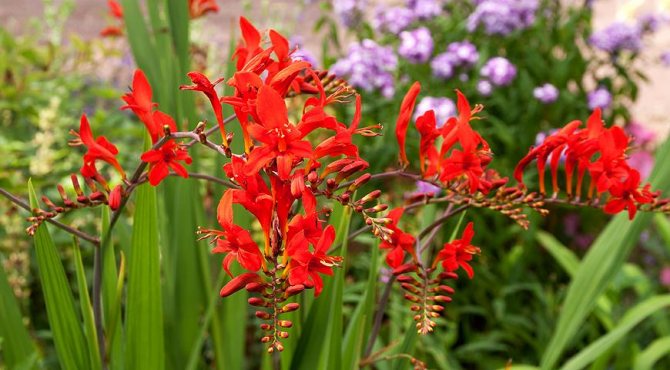

in the photo: blooming crocosmia or montbrecia
Tips for florists
- When planting freesias, consider the width of the leaves and spreading of each type of bush.
- For lush flowering, special conditions are required - temperatures up to +22 ° C during the formation of buds. Choose areas for planting freesia where the direct rays of the sun do not penetrate and the air does not warm up.
- Some types of freesia require props. For example, a broken freesia will survive better under the weight of the inflorescences if you provide it with support.
- Freesias love moist air, but their buds and flowers die or lose their decorative effect from drops of water falling on them. Spray the flowers, being careful not to hurt the inflorescences. The best time to hydrate is 5-6 pm.
- Cover your freesias with reflective material such as ground straw on warm, sunny days. The insulating layer should be 3 to 5 cm. Disinfect the straw by steaming.
Dahlia (Dahlia)
Dahlias are usually dug in late September - October, when the bushes turn black after the first frost. Before digging, the stems are cut at a height of 8–12 cm from the root collar. When removing root tubers from the ground, try not to damage the renewal buds located at the root collar - without them, the tubers will not germinate.
Dahlia nests are washed from the soil, carefully examined, heavily damaged tubers are cut out, thin feeding roots are removed and immersed in a solution of potassium permanganate for 30 minutes. Before storage for 7-10 days, it is useful to keep them at low positive temperatures. During this time, corking of the skin of the tubers will occur, preventing drying.
In storage, tubers are placed on shelves or in boxes. The optimum air humidity is 80%. In a dry room, the tubers dry out and shrivel. If moisture is difficult to provide, then the roots dahlias placed in boxes and sprinkled with sand, peat or sawdust. You can also protect them from drying out with the help of a clay talker, dropping the tubers into it and drying them until a crust forms.
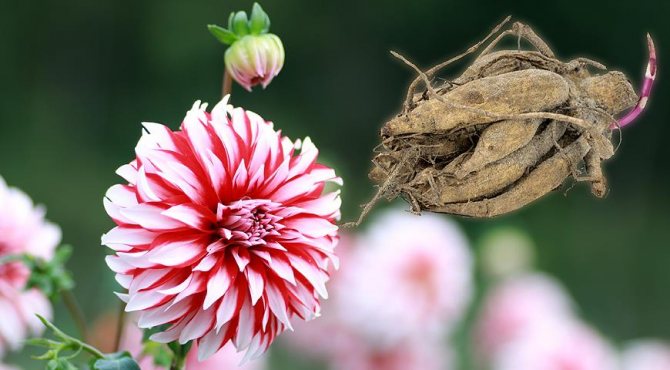

in the photo: a dahlia flower and its tubers
Waxing is sometimes used. Tubers are divided into sections so that each has 1-3 renewal buds. A water bath is arranged on the stove, paraffin is melted in a suitable container and for a moment the tubers are dipped into it one by one. When the film hardens, the procedure is repeated until the sections are completely covered with paraffin. After that, they are folded into a rigid container and stored.
A small amount of planting material can be stored until spring by wrapping it in several layers of damp newsprint, then wrapping it in kraft paper and placing it on the bottom shelf of a regular refrigerator. Damp paper needs to be replaced from time to time.
Diseases and pests, possible problems during cultivation
If you have followed all the rules for planting and caring for a flower, you will not have any special problems. It is important to remember simple rules:
- Observe the watering regime. Exercise it only in the root zone.
- Organize props.
- Remove faded shoots in time, this stimulates the development of neighboring buds.
- Leave at least a third of the stem when cutting.
- When growing, carefully monitor the background temperature. A long-term decrease in temperature to 13-15 degrees will prevent the development of a powerful peduncle, and heat above 25 degrees deforms the buds.
To achieve abundant flowering, you need to follow the storage rules. When the temperature drops to 20 degrees and below, the metabolic processes in the tuber slow down and it “falls asleep”. After waking up from such planting material, a stem may not form or empty buds may form.
The capricious southerner does not tolerate unnecessary manipulations with the root system. Therefore, if the place on the flowerbed turned out to be unsuccessful, you will have to try again only next year.
Know! compliance with the rules of cultivation is the key to abundant flowering and plant health.
Examine bushes closely for signs of disease. The iris family is susceptible to fusarium, scab. Corms are prone to rot. For the prevention of diseases, a double treatment with potassium permanganate, foundation is carried out. The soil can be additionally etched with a phytosporin solution. Moderate watering will also be a preventative measure. To prevent the disease from infecting neighboring bushes, infected specimens are dug up and burned.
Pests that can settle on delicate greenery include aphids, thrips and spider mites. They can be dealt with with chemicals, for example, "Aktellikom". For preventive purposes, the leaves are sprayed with a solution of laundry soap or infusion of garlic.
Freesia
These delicate plants are best grown in containers. They bloom in autumn. To make the flowering last longer, at the end of September, containers with flowers are brought into the room. Such a simple solution will allow the corms to mature properly (this is unattainable in the open air in the middle lane).
After the dying off of the aerial part of the corms, they are dug out, washed, disinfected and slightly dried. Recommended storage temperature +26. + 30 ° C. Freesia corms are small and very easy to dry out. Therefore, it is best to put them in sterile, tightly closed jars and place them near heating radiators or pipes. There are other recommendations, but we must honestly admit that no room storage method guarantees high-quality flowering.
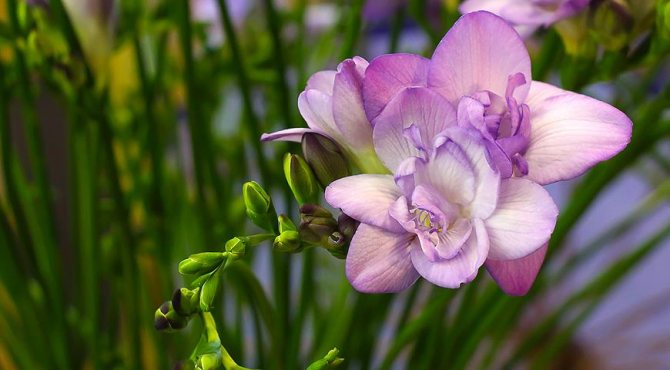

in the photo: freesia bloom
Freesia description, photo
Wild freesia live in Africa and grow exclusively in shady places along the banks of rivers. This bulbous perennial tuber of the iris family has a noticeable appearance. Long leaves grow from a small bulb covered with brownish scales. They have a distinct central vein and are similar to sedge leaves. Their width is about 1 cm, and their length is 15-20 cm.
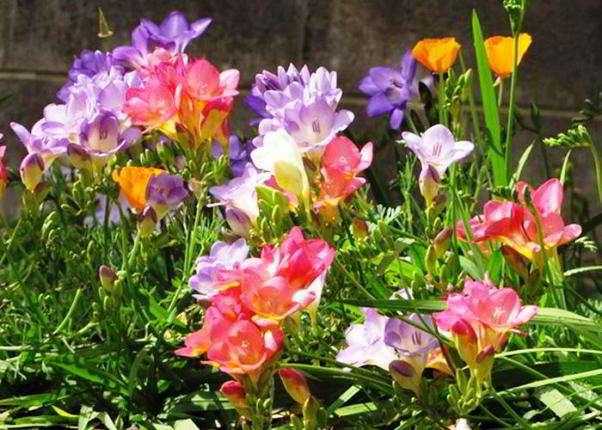

The flowering stem is long, glabrous, strongly branched in the upper part. He seems to bend to one side. In the lower part, the thickness of the peduncle reaches 4-5 cm, upwards it becomes very thinner.
On a note! You can grow a plant not only in the garden, but also indoors.
Flowering occurs in August and ends with frost. The number of flowers is from two to seven. They can have any shade, ranging from white to dark purple. Such a variety of flower palette makes freesia a welcome guest of any flower bed.
The flower is small, 3-5 cm, funnel-shaped. Its petals are narrow at the bottom, expanding upward and take on an oval shape. The inner part of the flower most often differs in color. There are three stamens and a pistil inside the funnel. The seed capsule consists of three chambers in which rounded brown seeds are located. The plant is propagated by bulbs, less often they are sown with seeds.
There are many legends about freesia, but the most beautiful one says that winter wanted to rule over the whole earth and took spring prisoner. She plunged her rival into eternal sleep in her icy dungeon. Flowers came to the rescue in the spring, making a magic ring. He awakened the spring from sleep and melted the ice palace. For this they were bestowed with a wonderful spring scent.
It is interesting! The legendary scent of flowers is a component of many perfumes.
The indigenous African woman is also appreciated by florists. It retains its original freshness for a long time in the cut. Delicate buds were also appreciated by brides, small bells harmoniously complement their bouquet compositions.
Growing conditions
To create the most favorable conditions for freesia, it should be grown in a greenhouse or greenhouse, but this method is more suitable for professionals or experienced gardeners. Such a plant, if necessary, can be cultivated all year round. However, in mid-latitudes, it is not able to survive the winter in the soil, therefore, corms are dug up in autumn. Such flowers can be grown at home, while indoor freesia begins to bloom in winter. There are basic rules regarding the growing conditions for all types of this plant:
- Such a flower is very fond of light, while the required duration of daylight hours for it is 12-14 hours.But it should be borne in mind that it does not tolerate the direct rays of the sun, therefore, a small partial shade should be chosen for planting it.
- The plant must be protected from drafts.
- The soil should be loose and well-drained. A soil mixture consisting of leafy, sod and humus soil, as well as peat, which is taken in a ratio of 1: 1: 1: 1, is best suited for growing. It is best if the acidity is low.
- If the variety is small-flowered and narrow-leaved, then it can be planted more compactly, while spreading, broad-leaved ones are planted more freely.
- In order to achieve abundant flowering, the temperature should be controlled. So, until the plant blooms, it should not exceed 22 degrees.
- Cutting flowers can be carried out only when at least 2 flowers bloom in the inflorescence. Flowers that have begun to fade should be cut off in a timely manner, otherwise they will take nutrients from those that have not yet opened.
- Some shrubs have weak stems (for example, the broken freesia varieties) and therefore need support.
- The flower needs high humidity. However, when spraying it, it should be taken into account that moisture should not get on the flowers or buds. It is best to spray at 17-18 hours.
- If the weather is extremely cold or hot, then because of this, the flowers begin to deform and many empty buds grow.
Freesia care videos
Despite its delicate appearance, freesia has an obstinate character. When growing a flower in the garden, it is important to find a bright, but protected from drafts place for it, provide the plant with a long daylight hours, but exclude the sun's rays during the hottest part of the day. The regime of watering and feeding is important. Mature plants tie up and mulch the soil around the bushes. For abundant and long-term flowering, the correct storage conditions should be organized for the corms.
You can also share your freesia care secrets. If you have any questions - ask them in the comments below, we will be happy to answer them.
Planting freesia bulbs for germination
You can use the most ordinary plastic cups (0.2 liters) as a landing container. Do not forget to make drainage holes in them.
Advice! If your bulbs are small, then in 1 cup you can plant 2-3 pieces, if large enough, then 1 piece.
The soil for planting must be used loose and airy. You can cook according to the following recipes: take humus, sod and leafy soil in a 1: 1: 1 ratio.
Step-by-step instructions for planting freesia bulbs for germination:
- Carry out preparatory procedures with the bulbs.
- Select the appropriate container and soil.
- Fill a glass halfway with earth and drizzle lightly.
- Place an onion in it.
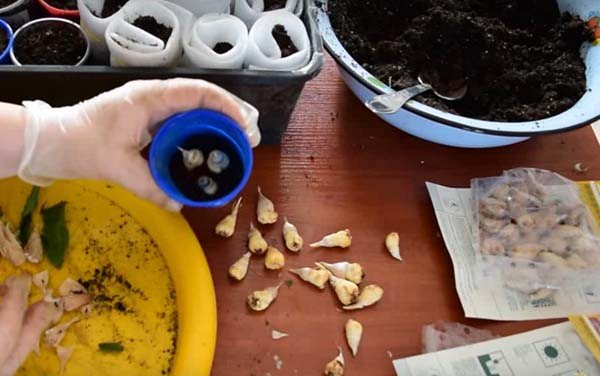

- Cover with earth so that the tip of the sprout sticks out slightly on the surface.
- Place the planting containers on the east or north window, where there will be no direct sunlight, or on the south or west, but be sure to shade.
Video: preparing freesia bulbs and planting them for germination
By the way! If you want to plant freesia babies for germination, then they need to be placed in a fairly deep pot (about 15 centimeters) at a distance of 1-2 cm from each other, depending on the size of the children. In this container, children will grow all summer, and in the fall they should be dug up and stored.
Freesia care after planting for germination
The optimum temperature for sprouting bulbs is + 15-18 degrees. In order to maintain such a low enough temperature on the windowsill, you can use a "screen", for example, from a ceiling tile. It is an effective protection against hot and dry indoor air.
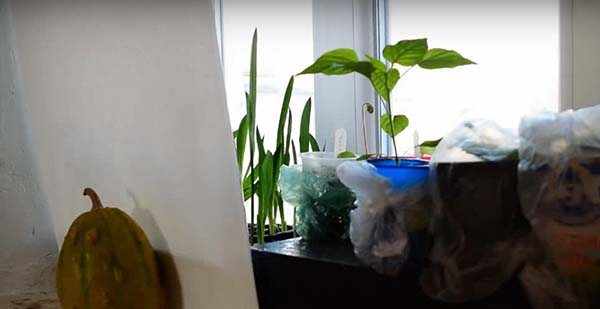

Important! At high temperatures, freesias inevitably stretch out and become thinner. As a result, their peduncle will be weak, and the flowers are small. It is unlikely that such a plant can please the eye.
Gradually, the temperature outside the window will begin to rise, and therefore on the windowsill, which should not be allowed, since the bulbs will begin to build up an excessively large green mass. Therefore, closer to the time of disembarkation, you should begin to carry out the planting during the day on the veranda or loggia, when the temperature there is set above +10 degrees, and at night, bring it in and return it back to the window.
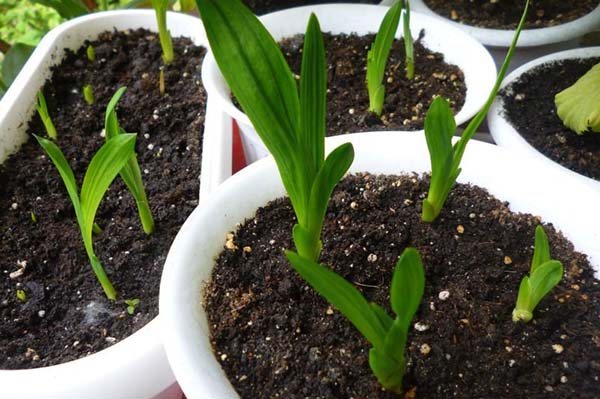

Watering freesia bulbs planted for germination should be done like ordinary seedlings, that is, as the soil dries up.
When the seedlings noticeably grow up, then it is worth installing small supports in the pot and tying up the freesia stalks so that it does not break off.
Optimal soil composition for freesia
Freesias do not like heavy clay soils. The most favorable for them will be light, oxygen-rich soils. You can prepare the soil for plants by introducing peat, humus, turf and sand.
If you plan to grow flowers at home, then ready-made soils for bulbous plants or universal soil, with the addition of peat, sawdust, perlite, are suitable. It is imperative to use drainage, such as brick chips, charcoal.
Expert opinion
Yulia Yurievna
I have a large garden and vegetable garden, several greenhouses. I love modern methods of plant cultivation and soil mulching, I share my experience.
Ask a Question
If you need to improve the soil before planting freesia, we recommend using only deoxidized peat. Or, you need to additionally add ash, dolomite flour to the soil. To make the soil lighter, you can add old sawdust. It is important to use the old ones that have lain for at least a year, because sawdust from fresh wood is able to extract nitrogen from the soil. The same material can be used for drainage. Expanded clay or gravel is suitable for the same purpose. When preparing the soil, it is important not to make it too light. Under these conditions, stagnation of moisture does not threaten the rhizome, but such soil will dry out very quickly. Lack of water can also negatively affect the condition of the flower. It's not just about the moisture itself, in such conditions the roots cannot be fully saturated with fertilizers and nutrients. When the soil preparation work is completed, you need to take a slightly damp handful of earth and squeeze it in the palm of your hand, if the lump keeps its shape, but begins to disintegrate quickly, the structure is optimal. If the soil mixture immediately crumbles, they are too light, you can add fertile soil from the site or from the forest to the substrate.
Popular varieties of freesia and their characteristics
Among the many plants, freesia terry mixture is distinguished by bright, delicate flowers that give off a pleasant aroma.
Perennial tuber-bulbous flower belongs to the iris group, which includes more than 20 species. During flowering, Freesia Mix catches the eye and pleases its owners with a mass of bright buds that resemble a carpet. The large, fragrant flowers are bell-shaped and come in cream, orange, pink, yellow, white, red, or purple. Where freesia blooms, there is a delicate scent of lily of the valley. You can see the article: Garden gladioli: planting and care in the open field.
Freesia Single Orange
Beautiful hybrid freesia, which belongs to the iris group. This variety is similar to the rays of the sun that illuminated the entire clearing. If you plant a flower in a whole flower bed, then such a decoration can be used for any corner of your suburban area. Freesia Single Orange blooms in May and pleases with its bright colors all summer. Its buds are narrow-funnel-shaped, emit a delicate aroma and are quite large in diameter, as they are 5-7 cm. The color of the flowers is bright orange, and closer to the base, the petals have a pale yellow tint, over which orange strokes are sprayed.
Freesia leaves are linear, narrow, dark green shade, which makes the flower more contrasting, interesting, unusual. Large buds are held by a strong peduncle, it is no more than 45 cm in height.Very often, Single Orange freesia planting occurs not only in the garden, but also in pots, which are placed on balconies and loggias. In the garden, the flower is used to decorate flower beds, rabatki, borders, flower beds.
No one remains indifferent to the aroma of freesia, so it is planted near houses, on balconies and even on the windowsill in order to constantly catch this delicate, pleasant, alluring smell. The plant is usually placed in groups of 10-20 pieces, which will make the flowering abundant, bright and saturated. In one flower bed, there can be both monochromatic varieties and multi-colored ones, so everyone decorates the plot to their liking.
To get large freesia flowers: garden care must be correct. For example, when choosing a site for planting, you need to know that the flower loves sunny, bright areas that are protected from the wind. The soil should be loose, sandy and well-drained, as well as warm enough. Lush blooms will require regular watering, especially during the hot summer months.
Corms are planted to a depth of about 6 cm, but care must be taken to ensure that the soil warms up to at least +8 degrees. When flowering is complete, it is necessary to remove all yellowed leaves and send the tubers for storage in a warm place, where the temperature is + 27-31 degrees, while the air humidity should be about 65-70%. After a few months, they can be prepared for the next planting. To do this, the bulbs must be kept at a temperature of 10-13 degrees for two weeks. Freesia Single Orange propagates by tubercules, corms and seeds. The flower does not tolerate frost, therefore, in the fall, its roots are dug up for winter storage in a warm place.
Freesia Single Yellow
Terry yellow freesia is a beautiful, flowering perennial plant that will be a harbinger of spring and a home decoration by March 8th. Its flowering in the ground begins in April and lasts until the end of September, the life expectancy of each bud is up to 10 days. Delicate, fragrant freesia Single Yellow is distinguished by a bright lemon-yellow color that immediately catches the eye. It has narrow, thin leaves of a dark green color, located on a strong peduncle up to 40 cm high. Flowers give a pleasant, rich aroma that you want to constantly hear on your site or balcony.
Very often, planting terry freesia Mix of this variety is performed when designing combined flower beds, where many shades of flowers are combined. Among the huge number of varieties, Single Yellow is used more often than others. This pattern is explained by the brightness of the buds, beauty and originality. Thanks to its shade and shape, the flower will transform every garden, make the flower bed more colorful, light, graceful. Very often, this hybrid terry freesia is planted in containers or beautiful pots, which are placed near the house, gazebo or along the garden path. If there is a multi-tiered flower bed in the garden, then it will certainly decorate it.
Before planting the bulbs, you need to know that red terry freesia and its other shades prefer sunny places where there is no wind and drafts, sandy, loose and drained soil. In order for its flowering to be lush, it is necessary to ensure regular watering, which is very important on dry, hot days. Corms are planted on the bed to a depth of about 7 cm, but you need to make sure that the soil warms up enough, so the planting time is in April or May.
When the flowering is over, all yellow leaves and inflorescences are removed, the bulb is dug up and sent to storage in a warm place, where the temperature is not less than +28 degrees, and the air humidity is 65%. By early spring, corms are prepared for planting. To do this, they are taken outside for two weeks for several hours, at a temperature of 10-13 degrees. Flower propagation occurs by seeds, corms or tubers.It must be remembered that the plant does not tolerate frost, therefore, even in the fall, the tubers need to be dug up, and then sent for storage in a warm place.
Freesia Single Lilac
Beautiful tall freesia, which is distinguished by a rather large height of peduncles - up to 80 cm. Usually their number is 2-3 pieces, where 7-9 large flowers are present. Its buds are light purple, not double, in the center are white. The plant blooms for no more than 20 days, so Single Mix freesia is planted taking into account this period. For example, if the house has a cool room, then the shelf life of the planting material can be slightly increased. Unlike other freesia varieties, Single Lilac has the shortest flowering period.
Freesia Double Mix
This variety blooms in April and August with a maximum duration of 12 days. Its stem is rather short when compared to other varieties, and is no more than 30 cm in height. Regarding site selection, Double mixed Freesia prefers wind-sheltered, sunny, warm lawns. The soil for planting it should be loose, sandy and well-drained. The plant needs regular watering, especially during dry months. The planting material for planting in the ground is examined for damage, and then buried in the soil by 6 cm. The planting is in April or May, when there is no threat of spring frosts.
When the Double Mix freesia has faded, it needs to be dug out, as it does not tolerate frost. Its corms are stored for the winter in a warm, dry place, where there is a sufficient indicator of humidity. In the spring, they can be planted directly into the soil or pots, which can be easily transferred to any place or placed on the balcony. This variety propagates, like other varieties of this flower - by seeds, corms, tubers.
Freesia Royal Ball
All bulbous freesias, including this variety, are perennials that have bright, double flowers.
They are at least 6 cm in diameter, so they will decorate any flower bed, especially if used in group plantings. Very often, the Royal Ball freesia is used for a cut, as with its help it is possible to create original, colorful compositions. This variety can have several shades of buds - yellow, white, pastel, purple and others. The flowers are collected in racemose inflorescences that have a pleasant aroma. Also read the article: Lily flowers: characteristics and nuances of growing an amazing plant.
Blooming freesia


Flowers appear in the second half of August, the flowering period lasts until the very frost. However, growers can independently adjust the flowering period of freesia, creating certain conditions for the plant.
Freesia flowers are collected in loose inflorescences. Peduncles are quite flexible and thin, to avoid damage, they are tied up. Modern varieties of freesia are very diverse: there are both simple flowers and double flowers with different colors: monochromatic or variegated.
To extend the flowering period with the onset of cold weather, containers with plants are brought into the room and dry peduncles must be cut off in time.
Double-flowered varieties are more capricious, more difficult to grow, the flowering period is short-lived.
Description of the flower
A beautifully flowering plant. Leaves are linear, funnel-shaped flowers, fragrant. The height of the flower is from 30 to 60 cm. The flowers are quite large, of various colors. The flower owes its name to the German doctor Frees.
Belongs to corms of the family Iris (Iris). It grows mainly in the Cape region of South Africa, tropical regions of Africa. One of the species was introduced from Sudan. In natural conditions, the bulbs doze for a long time in the ground until the start of the rainy season. With the appearance of moisture in the soil, they begin to actively develop, they release flower stalks with beautiful flowers. In a drought, the aboveground part dies off completely, the bulbs go into a dormant state.
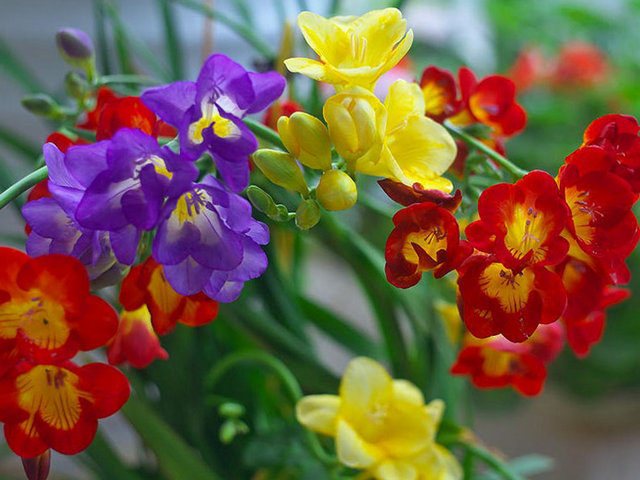

Interesting! Freesias were brought to Europe a long time ago - two centuries ago. They were actively cultivated in gardens, then migrated to window sills, began to be grown as a houseplant. Freesia contains essential oils used in perfumery. When cut, the flower retains its freshness for a long time.
2.Description - how freesia looks and grows
The genus contains 19 perennial bulbous plants.
Conical bulbs reach a diameter of only 2.5 cm.
Leaves green, xiphoid, erect, basal, 10 - 30 cm long.
Peduncles tall, leafless, vertical, each carries several flowersopening sequentially - from bottom to top.
The shades of the petals include the entire color gamut, except perhaps black. Bred varieties with flowers in contrasting tones.
Blooming freesia emits a very pleasant scent... For this aroma, reminiscent of the smell of lily of the valley flowers, the plant was given a second name - Cape lily of the valley.
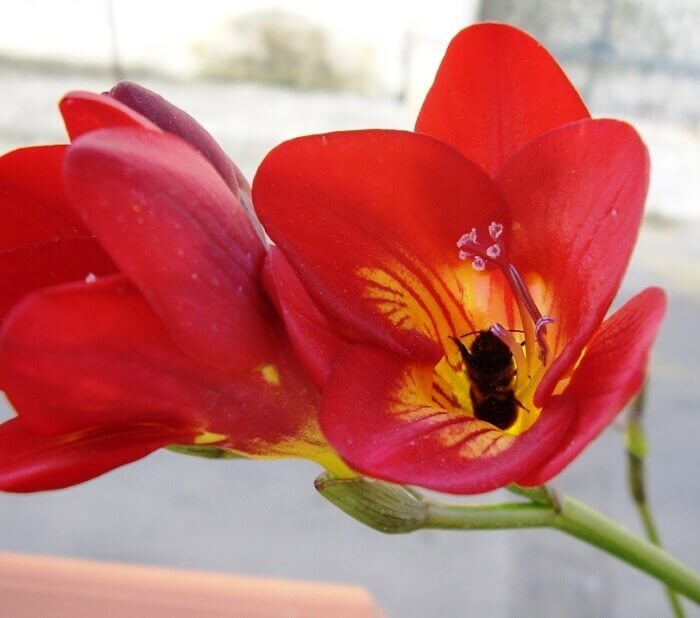

Height. 15 - 40 cm... The final size of the flower will depend on the varietal characteristics and conditions of keeping.
Interestingly, plants with red and yellow flowers are the fastest growing.
↑ Up,
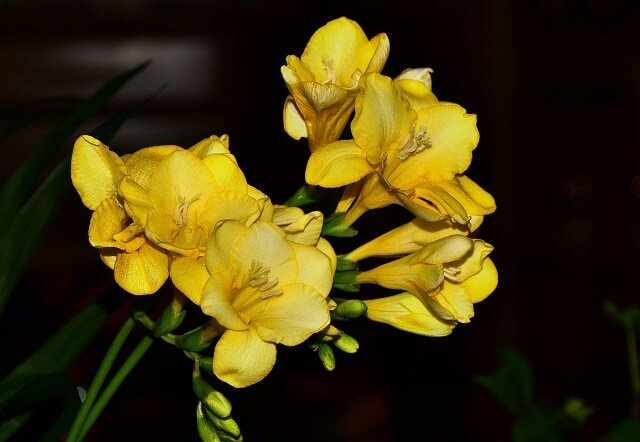

Note to the florist
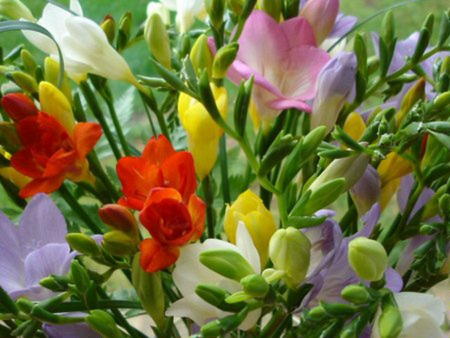

Why do freesia leaves dry?
Leaves can dry out from lack of moisture, both in the soil and in the air. Also, yellow and brown spots appear from sunburn and an excess of fertilizers in the soil.
Why doesn't freesia bloom?
As a rule, the buds on the plant do not appear after the incorrect content of the corms (in a too warm room).
Why doesn't freesia emerge?
Sprouts do not appear mainly due to improper preparation of the bulbs for planting. Perhaps the planting material was not treated with a growth stimulant and was not soaked in a solution of potassium permanganate. It is also possible the option of improper storage of corms after digging up.
Sowing seeds
Freesia seeds are rarely propagated. The optimal sowing period is late April — early June. The seeds are soaked for a day. Spread evenly over the surface of the prepared substrate for freesia, lightly sprinkle it with earth on top. When shoots appear, the sprouts are thinned out, in the phase of two true leaves they dive into separate cups.
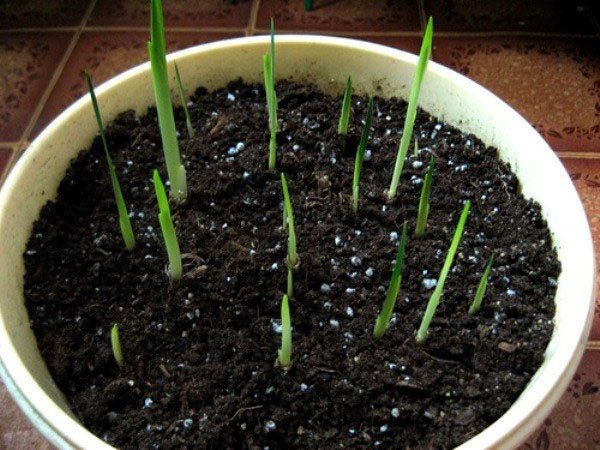

Freesia shoots
Freesia rose
The freesia rose flower has a bright yellow evenly colored color.
Terry freesia resembles the shape of a bowl, and also has a wonderful aroma. The inflorescences are harvested up to eight flowers! The rose blooms, as a rule, one of the very first, even at the beginning of the summer period, and the flowering is quite abundant, and throughout the season! Flowers that wither will fall off quickly. But due to this, the bush always looks very neat.
The rose has bright green leaves that are shiny and disease-resistant enough.


The height of straight-growing bushes reaches up to 80 cm, while they are quite winter-hardy.
Types and varieties
The most common is considered a hybrid freesia, which was obtained by crossing several varieties. But there are other, no less common types of culture that also deserve the attention of flower growers (Figure 2).
Popular varieties of freesia include:
- Armstrong - a relatively short plant (up to 70 cm) with pink or red bell-shaped flowers.
- Hybrid combines the best qualities of the species that were used to create it. The height of an adult plant reaches a meter, and the buds of a wide variety of shades are collected in small inflorescences. This species includes the varieties Ballerina, Rose Marie and Pimperina.
- Broken differs in thin stems and spreading inflorescences of a white or yellowish tint.


Fig. 2. Popular varieties of culture: 1 - Armstrong, 2 - hybrid, 3 - broken
All of the types described above can be either simple or terry. It is noteworthy that not only one particular variety, but also a mixture of different species can be grown on the same bed.
How to plant freesia using seeds
As you know, freesia propagates not only by bulbs, but also by seeds. This is a rather laborious process and does not guarantee a good result. Freesia seeds are usually used by breeders to develop a new variety. To grow freesia from seeds on your own, several conditions must be met:
- soak seeds in growth-promoting preparation for about twenty-four hours;
- prepare pots with soil, plant seeds there, pressing them a little into the ground;
- cover the seeds planted in the ground with foil and put the containers in a bright place, preferably on a window on the south side;
- raise the film every day, ventilate and spray the ground with water;
- as soon as the seeds sprout and sprouts appear, the time they spend without the film increases, later it is removed completely;
- plant the sprouted sprouts at a distance of at least 6 centimeters between them;
- put supports for plants and, as necessary, tie the stems to it. It is better to do this before the plant grows, otherwise the roots of the flower can be damaged by the support;
- periodically water and fertilize flowers.
If these conditions are met, freesia will bloom in a few months.
Planting freesia seeds
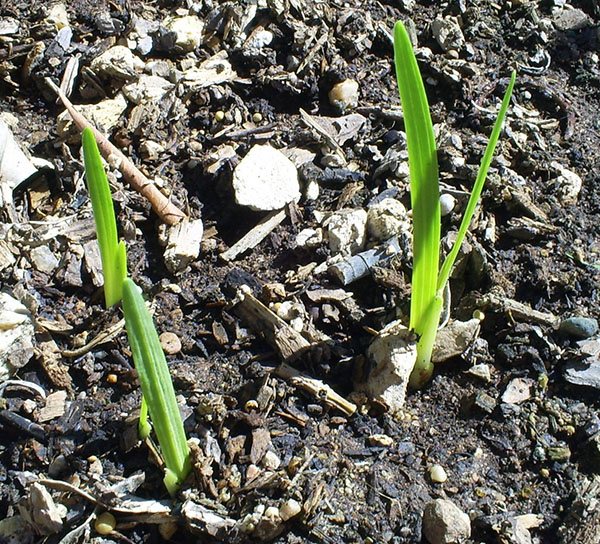

Like many related species, freesias can be propagated by seed. From the moment of sowing to the appearance of the first buds, at least 8-9 months should pass. If you plant freesia in the ground in the fall, in the spring, plants that have already gained strength are taken out into the garden.
Sowing is carried out with seeds pretreated with potassium permanganate or phytosporin to a depth of 3-4 mm. The best results can be achieved in a home greenhouse, where it is easier to maintain increased soil and air humidity. Until shoots appear, the soil is moistened with a spray bottle. Then accurate watering and illumination, which is indispensable in the autumn-winter period, is possible. Planting and caring for freesias outdoors is no different from caring for plants from adult bulbs.
Preparing the soil for planting
The soil can be bought ready-made, suitable for bulbous, or you can do it yourself. The following components are required:
- sod land — 30%;
- peat - 20%;
- humus — 30%;
- coarse sand — 20%;
- it is advisable to add a handful of wood ash (for deoxidizing the soil) and bone meal (for calcium enrichment).
It should be borne in mind that the flower grows well on neutral soils (pH 6-6.8). If necessary, add dolomite flour to the soil.
The soil must be disinfected by spilling with a phytosporin solution.
Pruning freesia
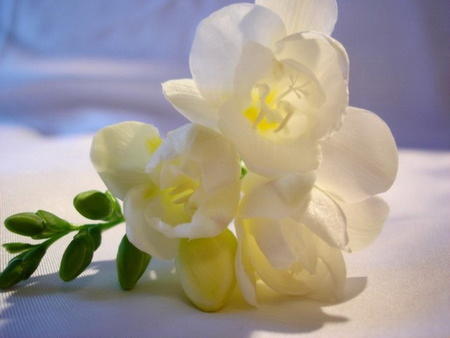

Freesia pruning is done to stimulate the re-emergence of the inflorescence on the plant. There are certain rules for pruning flowers and leaves.
- Pruning a withered flower
- The optimal pruning period is when the inflorescence has bloomed, but the fruit has not begun to form.
- A garden pruner or kitchen shears are used for pruning.
- Pruning is carried out half a centimeter below the flower located at the top of the stem.
- Do not cut the leaves
Leaves should not be cut at the end of the flowering period, as the leaves help the plant accumulate strength for wintering.
- Leaves are cut off after complete drying
It is best to prune the foliage when it turns yellow or brown.
- It is necessary to cut off the leaves, leaving a stump 5 cm high.
- If the cut leaves are healthy and free of signs of disease or insect damage, they can be used for compost.
Decorative use of freesia
Possessing a pleasant aroma and graceful forms, the plant has long attracted the attention of florists and landscape designers.
Floristics
Florists actively use all varieties of hybrid freesia when making bouquets and flower arrangements. Their shades are very diverse, the peduncle is strong and even the leaves are highly decorative. In addition, virtually all freesia varieties are available throughout the year, and cut flowers stay fresh for up to two weeks.
They go well with calla lilies, irises, orchids, roses and other representatives of the aristocracy of the floral world. These delicate flowers are often used to decorate wedding bouquets.
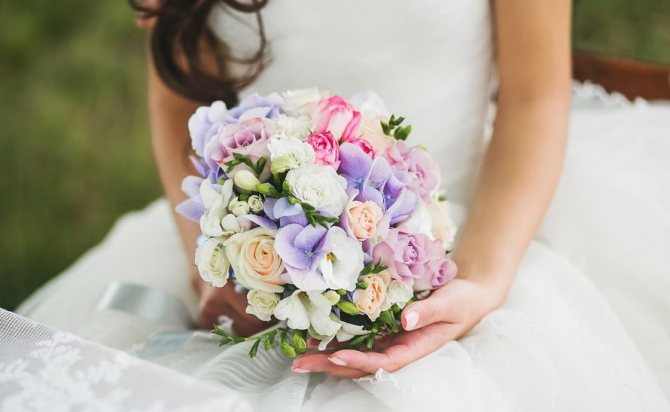

Bridal bouquet of roses, freesias and hydrangeas
Landscape design
Freesia will adorn any part of the garden, as it can grow on flower beds, and on alpine slides, and in solo plantings, and in flowerpots or containers. The flower looks good in combination with other ornamental crops, and also finds its rightful place in aromatic beds among such fragrant herbs as rosemary, thyme, lavender.
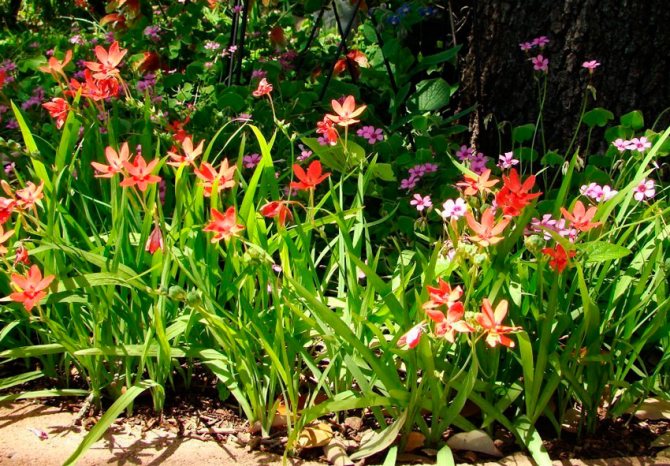

Freesias thrive in the canopy of tall trees
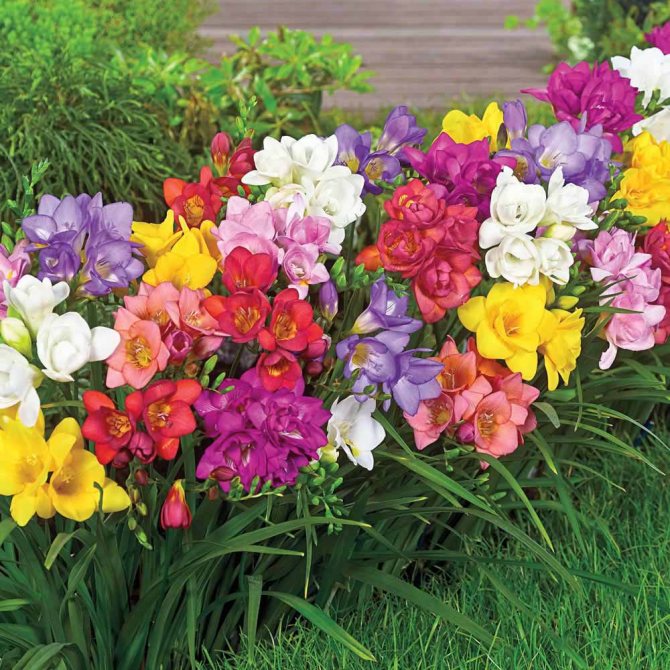

A flower bed of multi-colored freesias, matched by height
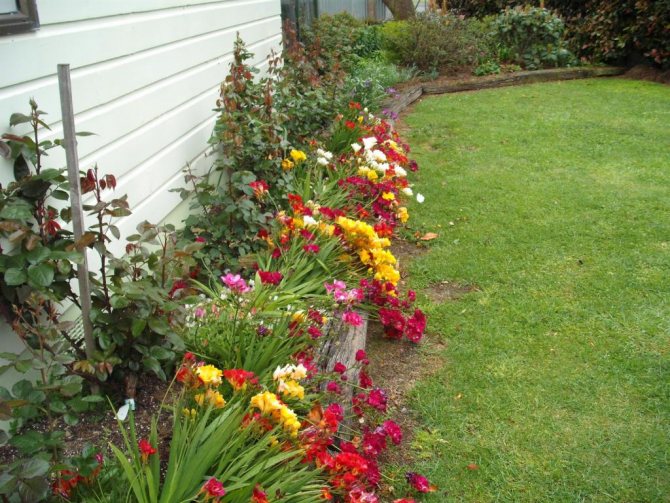

Freesia border
Growing
The peculiarities of growing freesia depend on where it will grow.
In the open field
Bulbs prepared for planting must be carefully examined:
- Healthy planting material should not dry out, without soft areas, rot and mold.
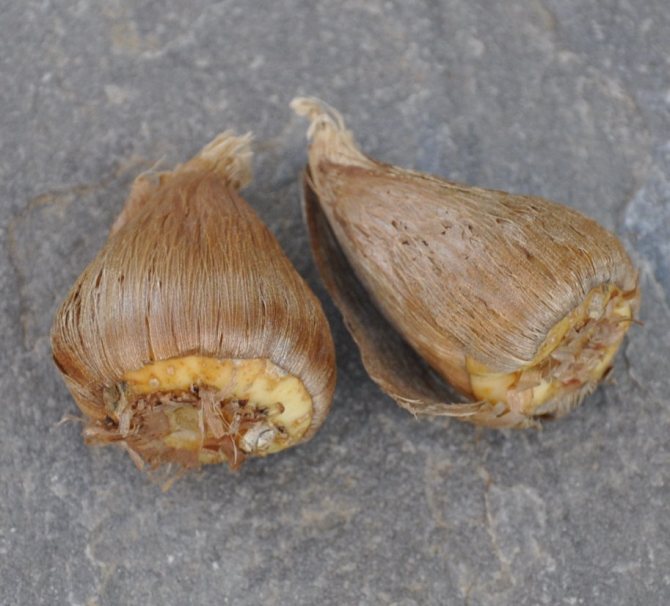

Healthy Freesia Bulbs
- At the end of March, they need to be cleaned of hard scales, and immersed in a solution of Fitosporin or another fungicide for half an hour to prevent rotting and reduce the risk of fungal diseases.
- After this treatment, the bulbs are planted in pots for germination. One at a time in small containers or 5-6 pieces in large ones, with a volume of about 3 liters.
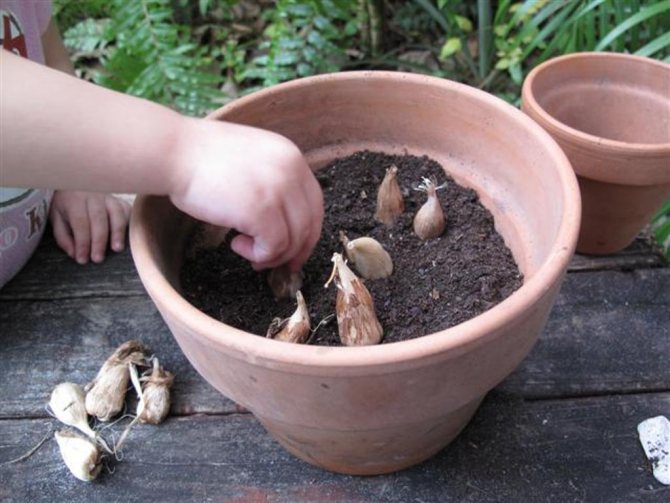

Planting bulbs for germination
- They are buried 5 cm and the pots are placed in a warm and well-lit place.
- All care is to keep the soil moist.
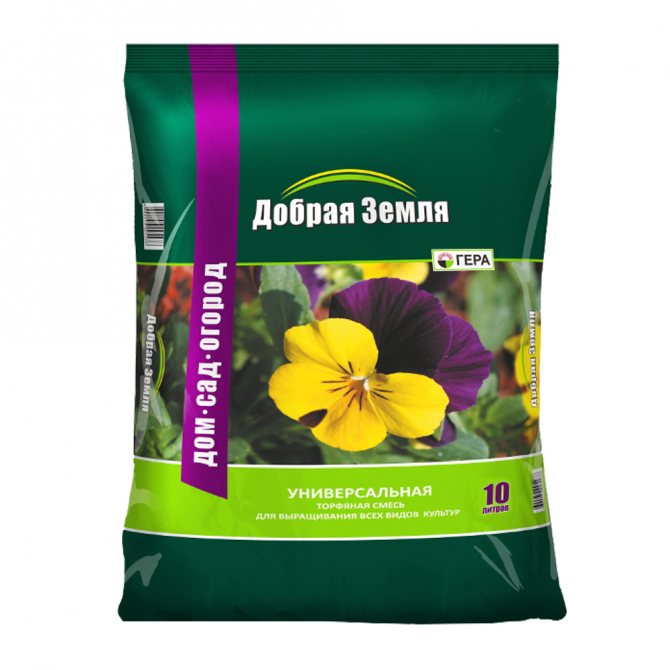

For germination, you can use universal or special soil for bulbous plants.
When the threat of frost has passed, the sprouted bulbs can be planted in the ground. You need to choose the right place for the plant.
This southerner is very thermophilic, does not like drafts and direct sunlight. But it is absolutely impossible to deprive it of light, it is desirable to provide a slight openwork shading in the hottest midday hours.
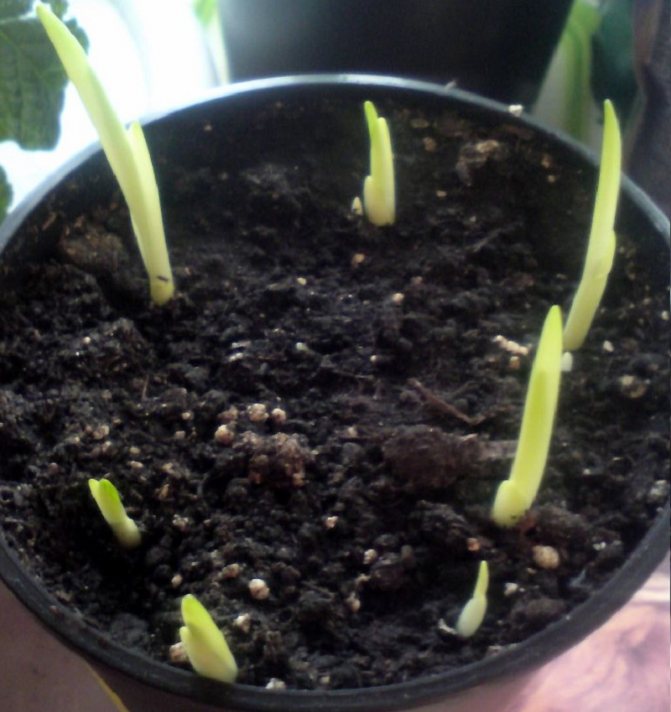

As soon as the weather permits, the sprouted bulbs can be transplanted into the open ground.
As for the soil, it should be loose and not acidic.
Therefore, it is advisable to introduce a soil mixture consisting of equal parts into the dug holes or grooves about 40 cm wide and deep:
- Humus;
- Peat;
- Compost;
- Garden land;
- River sand or vermiculite.
Advice. To deoxidize the soil, lime or wood ash is added to the specified mixture.
It is also desirable to fertilize the soil before planting by mixing the prepared soil with phosphorus-potassium and nitrogen mineral fertilizers.
- The distance between plants in a row should be 3-5 cm, depending on the size of the bulbs;
- The distance between the rows is 15 cm;
- Planting depth, depending on the variety and plant height, 3-6 cm.


In the southern regions, the bulbs can be planted immediately in the ground.
Plants planted in May in the middle lane in the open field bloom in August.
Indoor conditions
The popularity of freesia as a houseplant is due to its ability to bloom at any time of the year, depending on the timing of the germination of the bulbs in the pots.
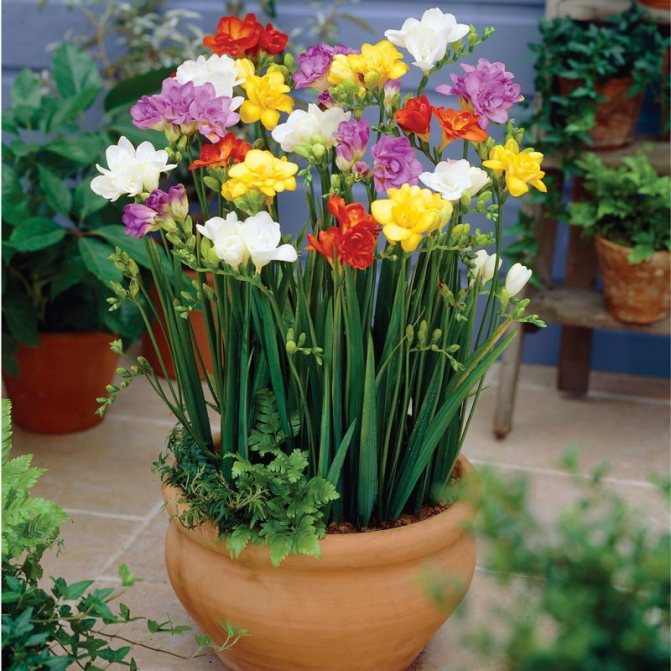

Mix of different varieties of freesia in one pot looks amazing
Advice. In order for the plant to bloom in winter, it must be planted in a pot in August-September.
- As well as before planting in open ground, the bulbs must be treated with fungicides and growth stimulants in order to "wake up" them at any time of the year and stimulate rapid development.
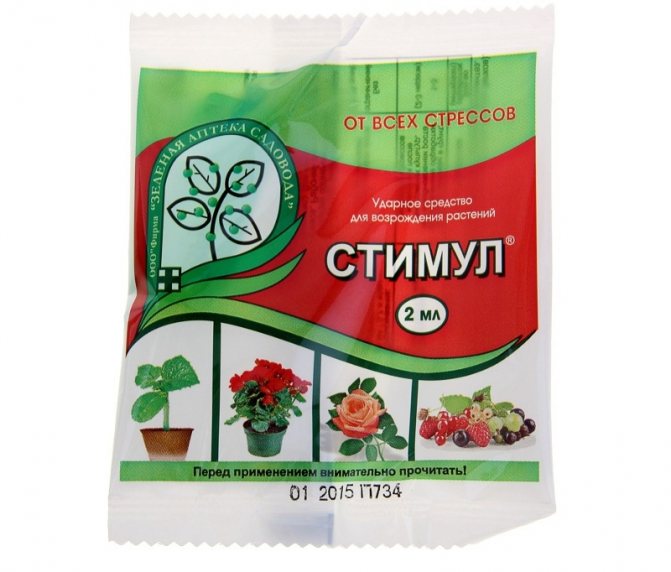

Even externally healthy bulbs need to be processed.
- As with most cases, planting freesia requires containers with drainage holes at the bottom to drain excess water. But this is not enough: at the bottom it is also necessary to lay a layer of expanded clay or small pebbles, and on top of it - a layer of charcoal.
- The remaining space is filled with soil for bulbous plants or a self-prepared soil mixture from equal parts of garden soil, peat and humus, mixed with mineral fertilizers containing phosphorus and potassium.
- The bulbs are buried 5-6 cm into the ground, planting up to five bulbs in each 1.5-2 liter pot.
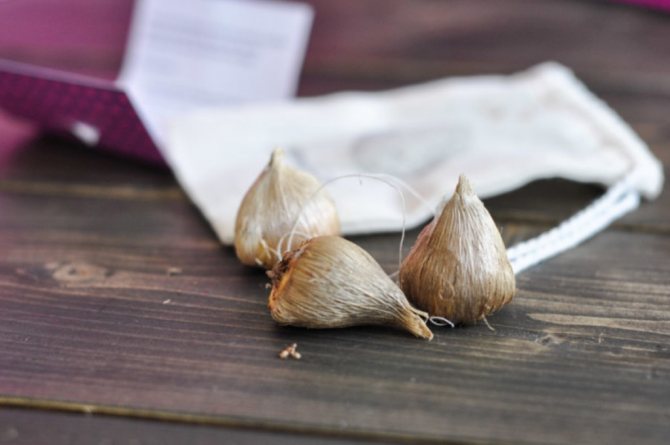

The number of plants is selected according to the size of the bulbs - they should be free enough
- They are first installed in a cool room with an air temperature of about 12 degrees, and after the appearance of the first leaves, they are transferred to heat and the temperature is maintained at 20-22 degrees.
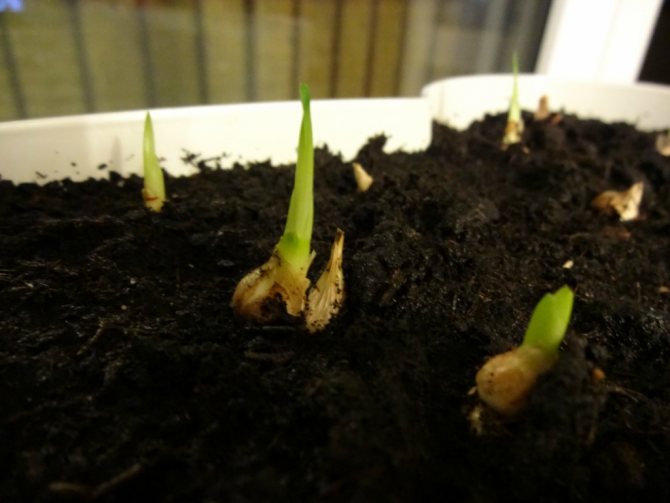

Young sprouts need warmth and moisture
In the greenhouse
In heated greenhouses and greenhouses, freesia can be grown all year round. But even in unheated ones, it is possible to create conditions for the plants to bloom not in August, but much earlier - at the beginning or in the middle of summer.
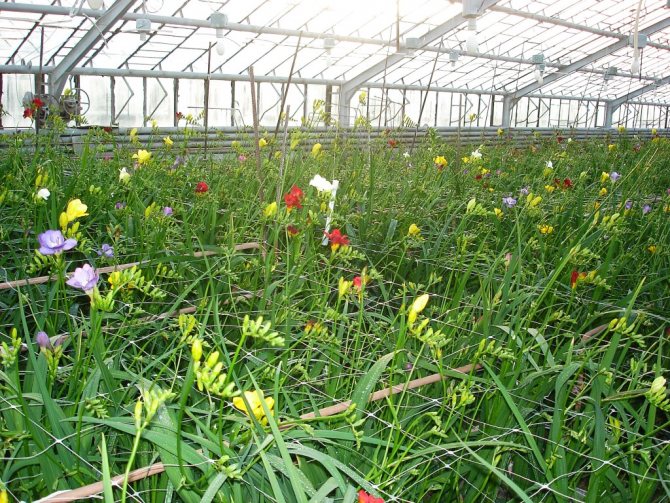

Blooming freesia in a greenhouse
For this you need:
- Maintain a constant air temperature during the day and night. It is its large differences that cause growth retardation and lead to freesia diseases.
- Eliminate drafts.
- Maintain air humidity at least 50%.
Seed propagation
You can also grow freesia from seeds. But this can only be done by experienced gardeners, those who want to experiment with breeding. For the seeds, the soil is prepared and moistened. Seeds are laid out on it and sprinkled with earth on top of 2 cm. From above, the container is covered with foil and placed in a well-lit place. The seeds will sprout in about three weeks. During this time, they need to ensure regular watering. When the seedlings stretch 2-3 cm, you need to remove the film and thin out the seedlings. They are planted in open ground in the same way as bulbs in mid-May. The main problem with growing freesia from seeds is the risk that they won't sprout at all.
Freesia features
What are the features of freesia:
- such a delicate flower can decorate any bouquet, it is especially popular with brides;
- for a long time does not lose freshness and does not fade;
- used in the manufacture of luxury perfumes;
- is very popular with landscape designers;
- she can decorate any garden or greenhouse, as well as a window sill;
- the yellow-red variety differs from other varieties in its rapid growth.
The bush of hybrid freesia can reach a height of 100 centimeters, the highly branched stem is bare, thin light brown scales cover the corm. The length of thin leaf plates with a midrib can vary from 15 to 20 centimeters, and the width - from 10 to 15 millimeters. Weak unilateral inflorescences are composed of fragrant flowers, the length of which is from 30 to 50 mm Flowers can be painted in different colors, for example: red, blue, yellow, pink, white, orange, purple, cream, etc. Often the petals and throat have a contrasting color. The fruit is a capsule.
Reproduction
Reproduction of this plant, just like gladioli, occurs: tuber, seeds, and also corms. The seeds are in the seed capsule. One box contains two brown seeds. During the ripening period, pollination should be carried out in the morning when the weather is clear. Watering cannot be stopped, it is necessary to feed with microelements, as well as fertilizer with potassium.
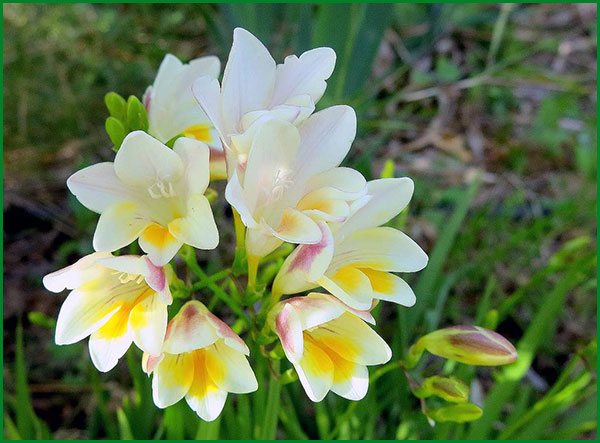

Freesia Broken
Freesia seeds are propagated during selection, as well as with a shortage of planting material. Corms and flowers can be grown from them on windows facing west or east. It is best to use freshly harvested seeds. Before planting, they will need to be kept in a potassium permanganate solution for 15 minutes. Seeds should be immersed in compost, preferably steamed, in mini-greenhouses under a polyethylene film. They need to be ventilated every day. When shoots appear, they will need to be placed in a bright room, but not in direct sunlight. You can take them out on a cool glazed loggia.

